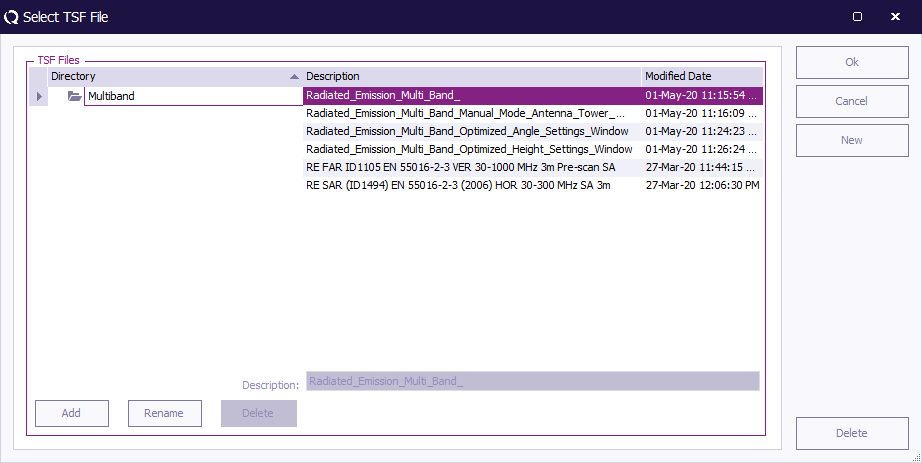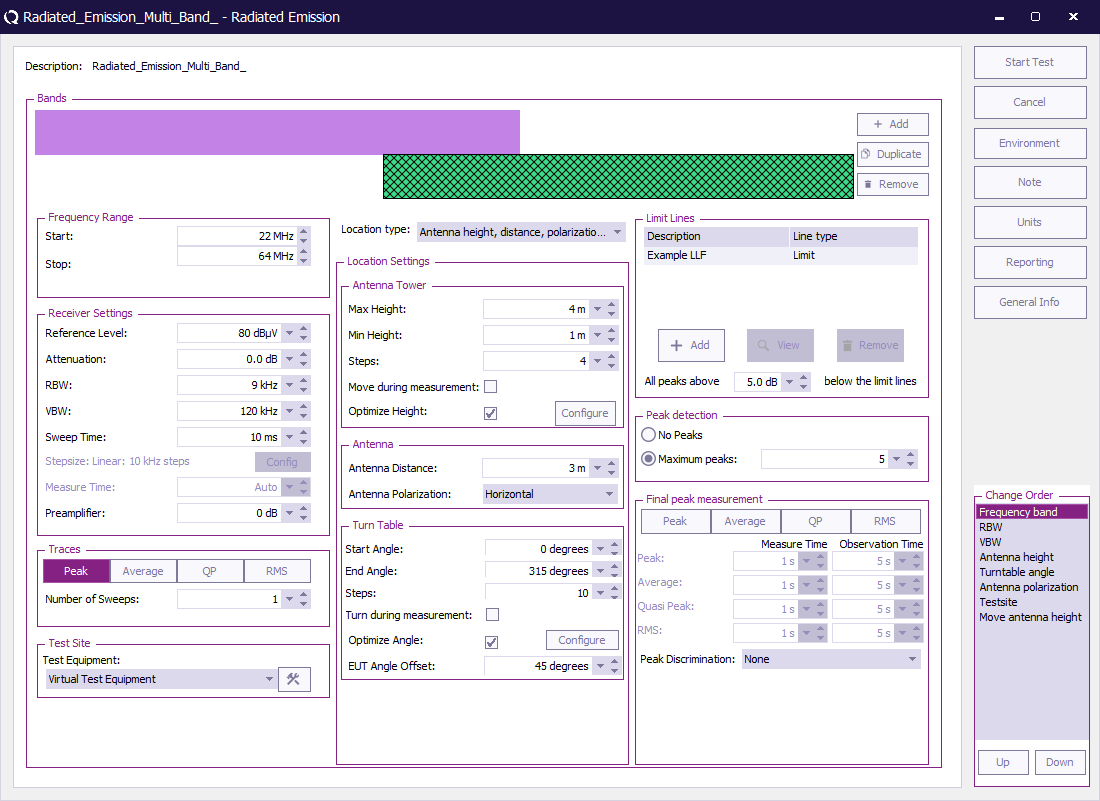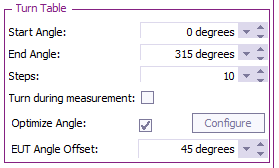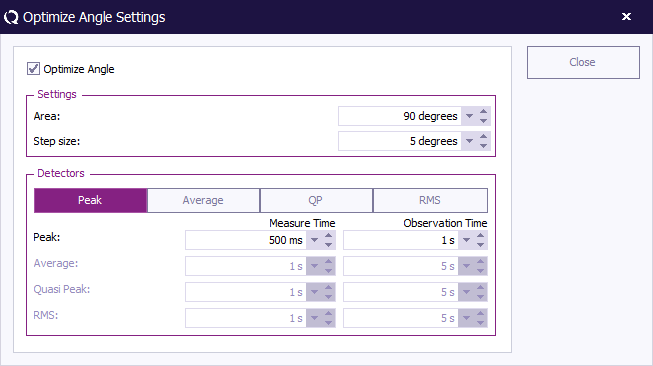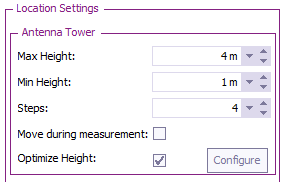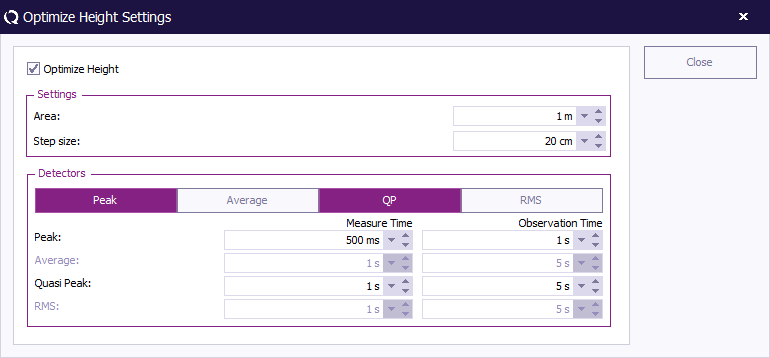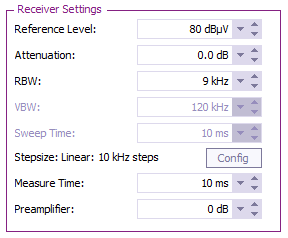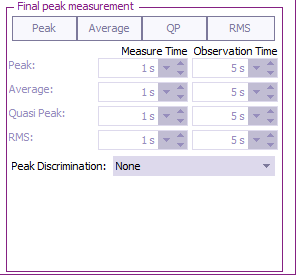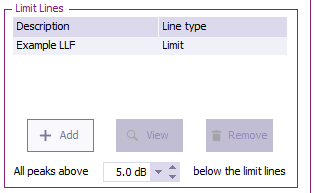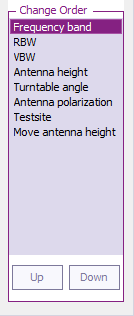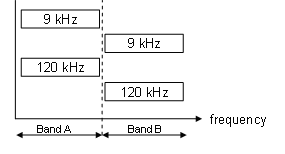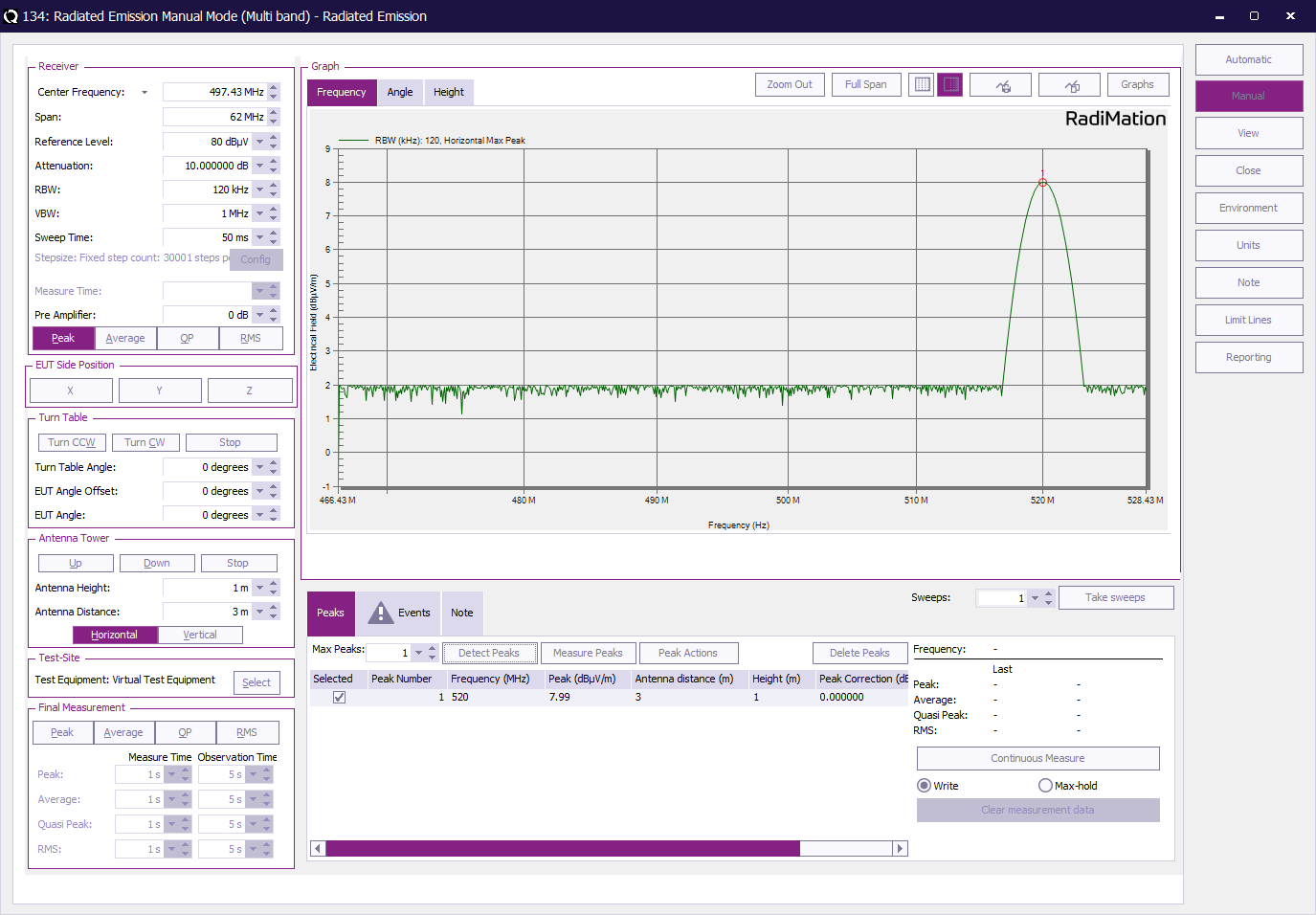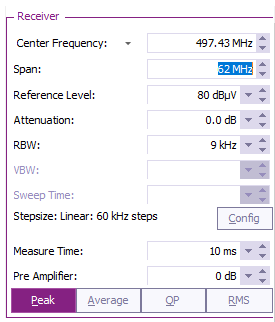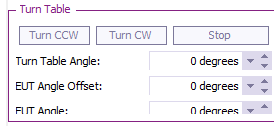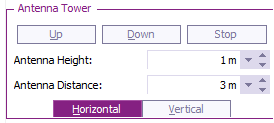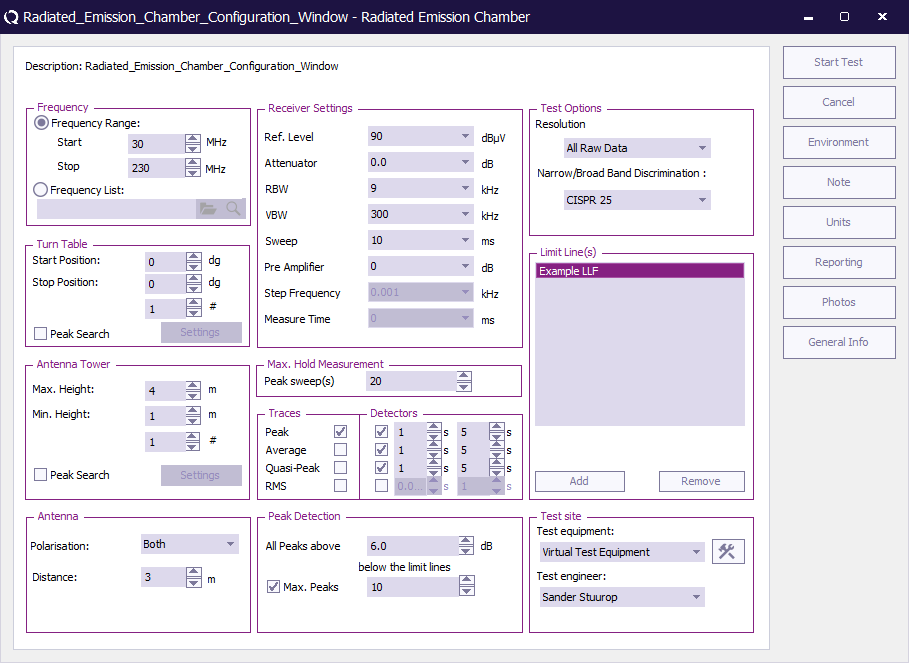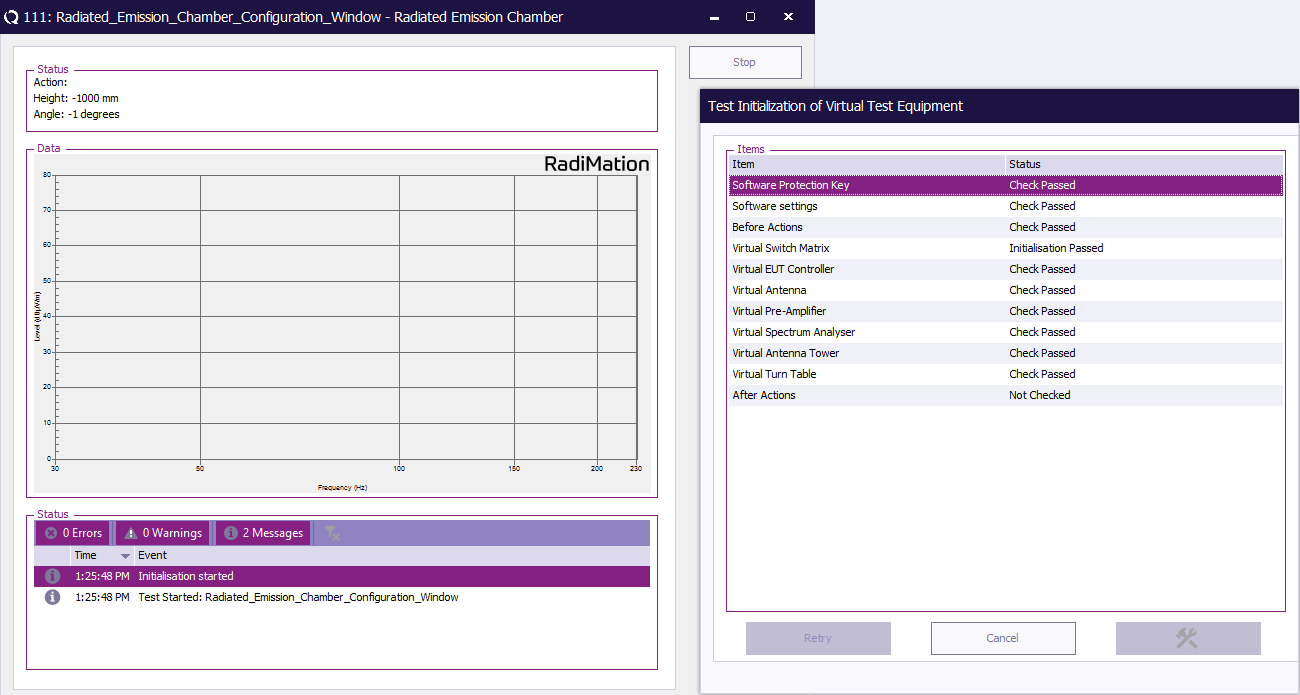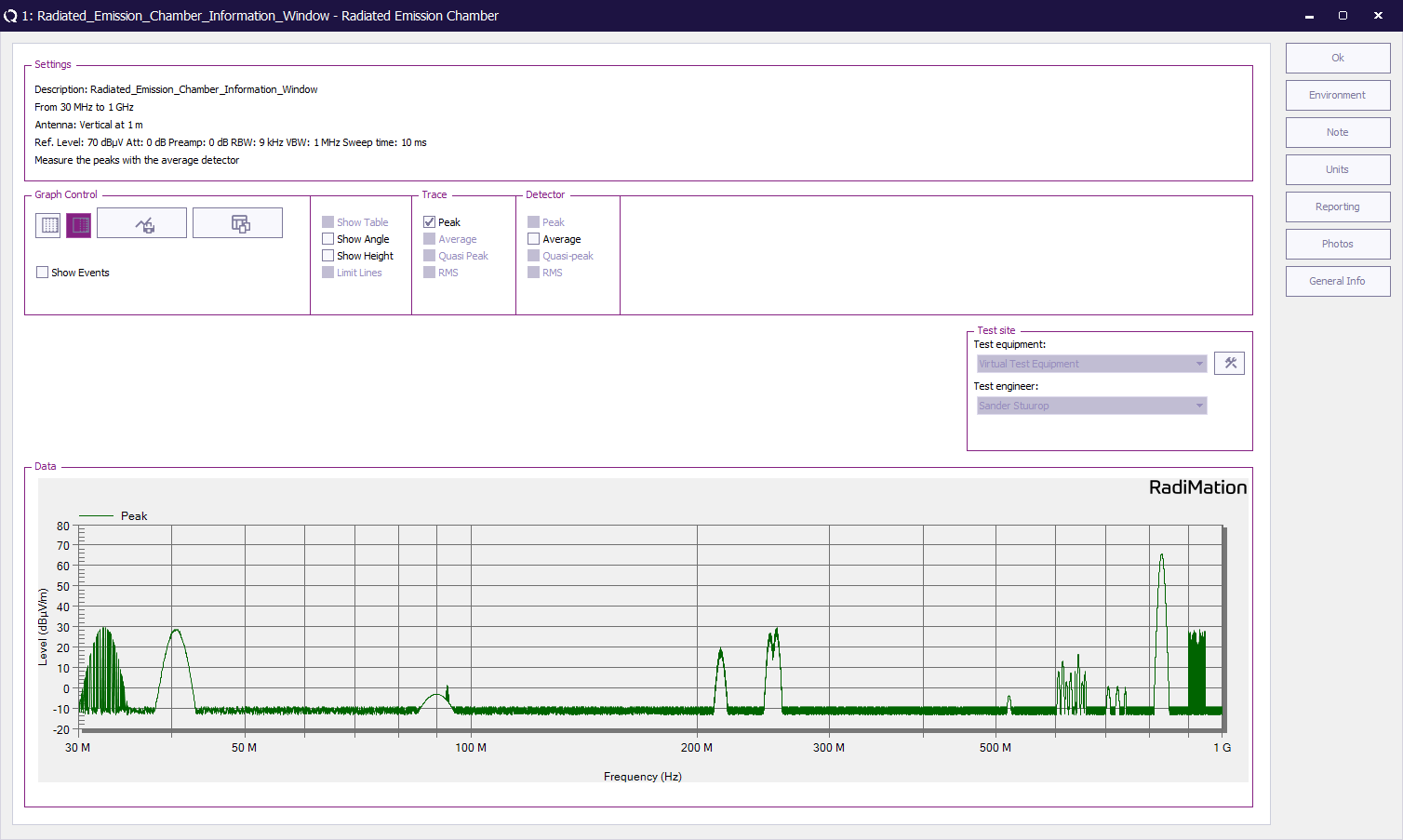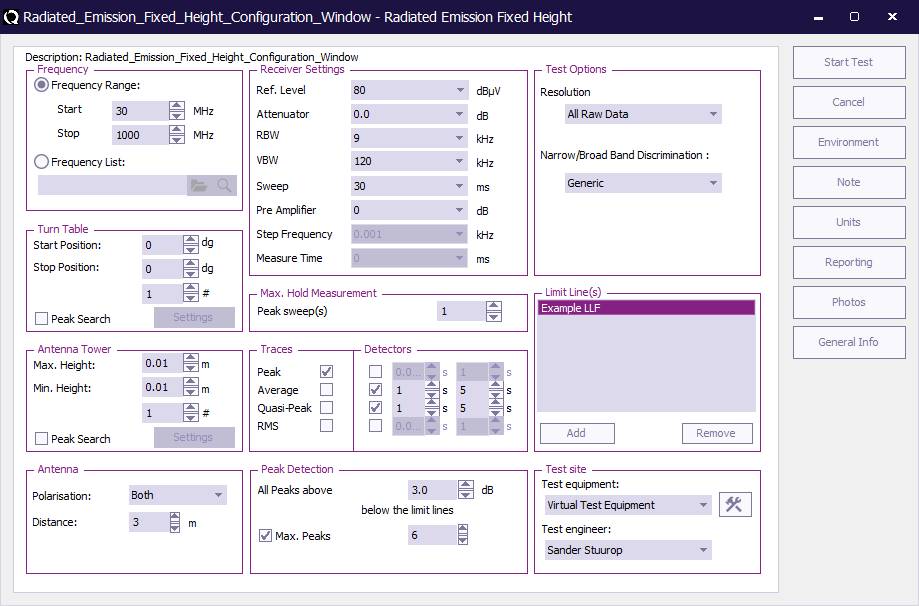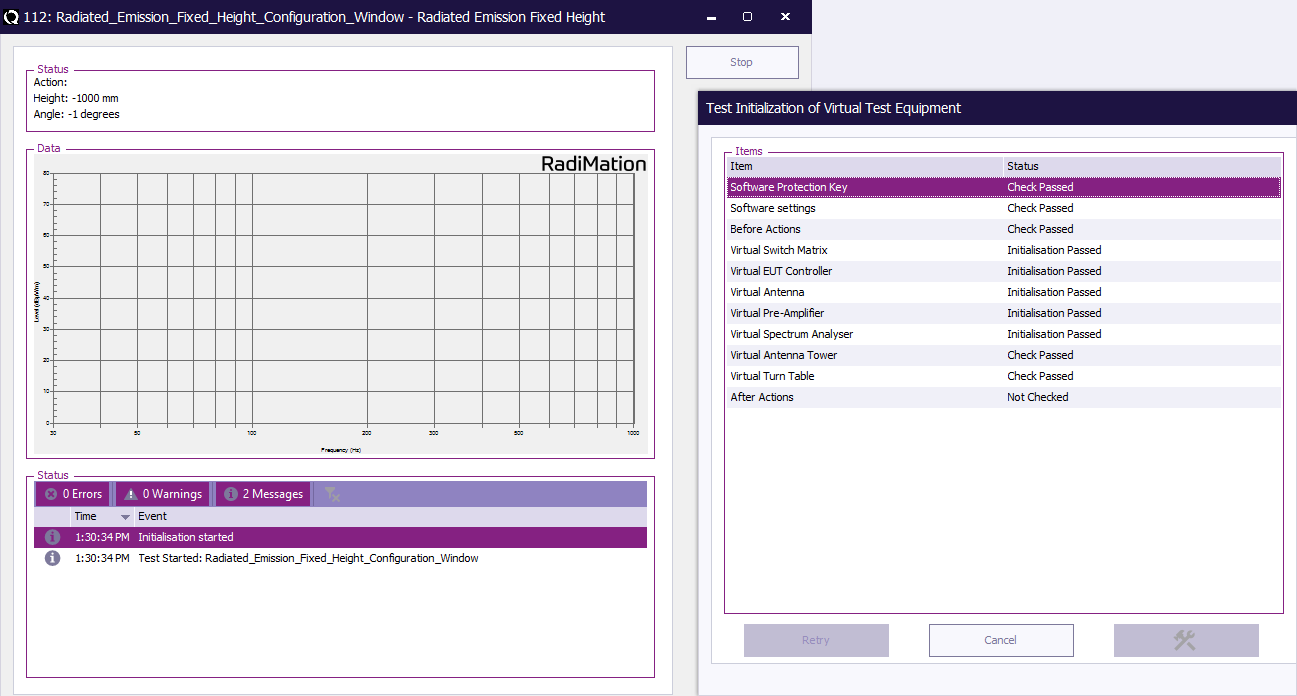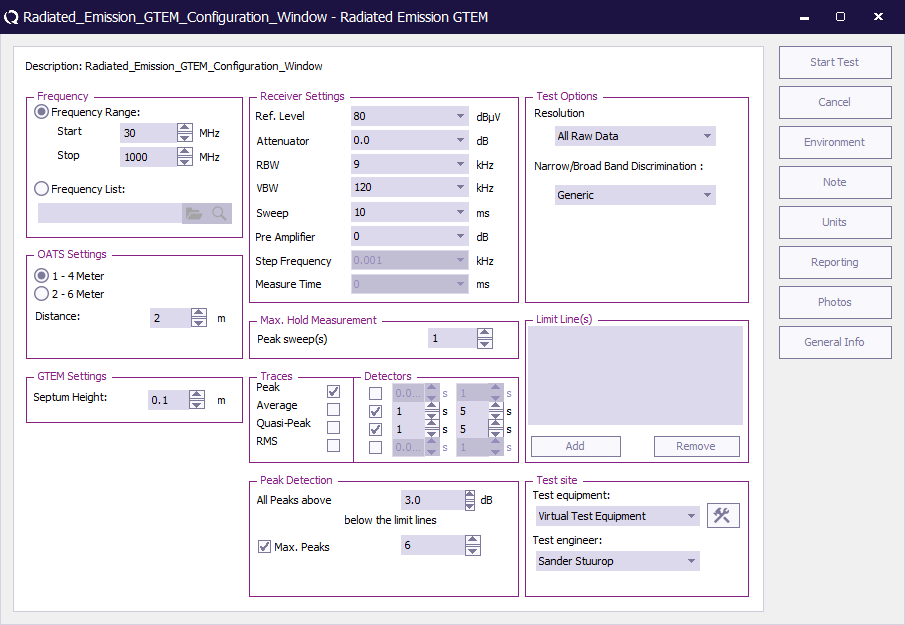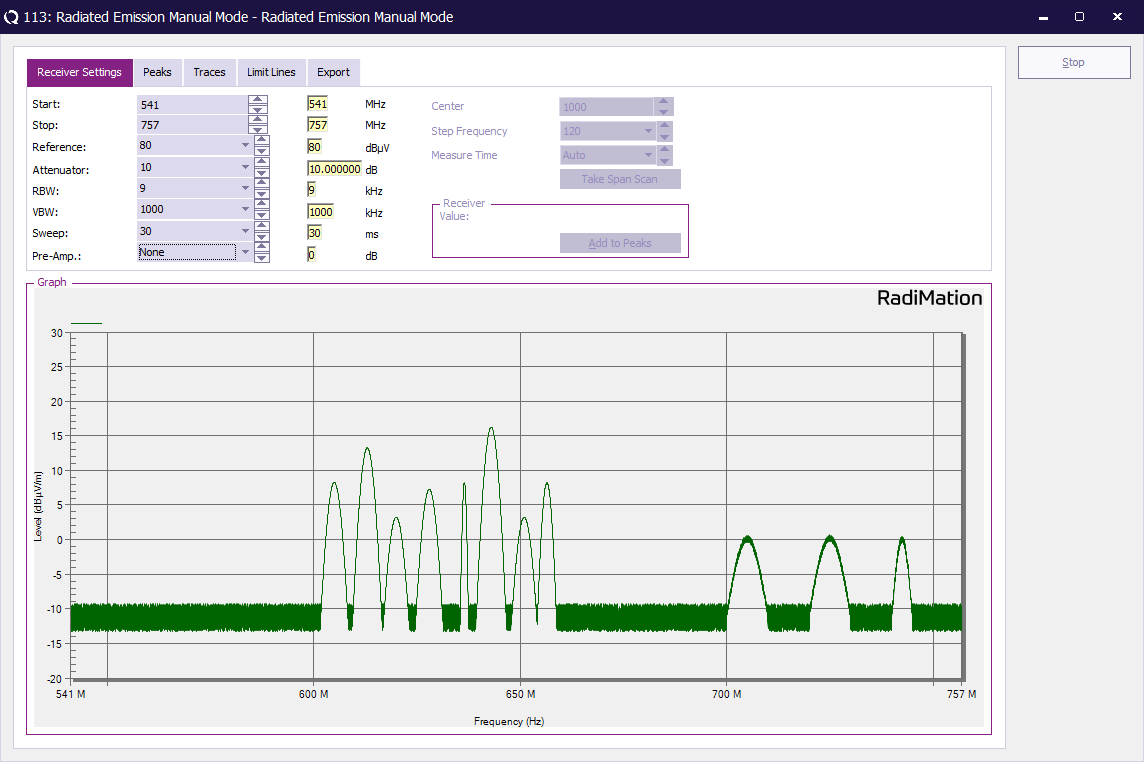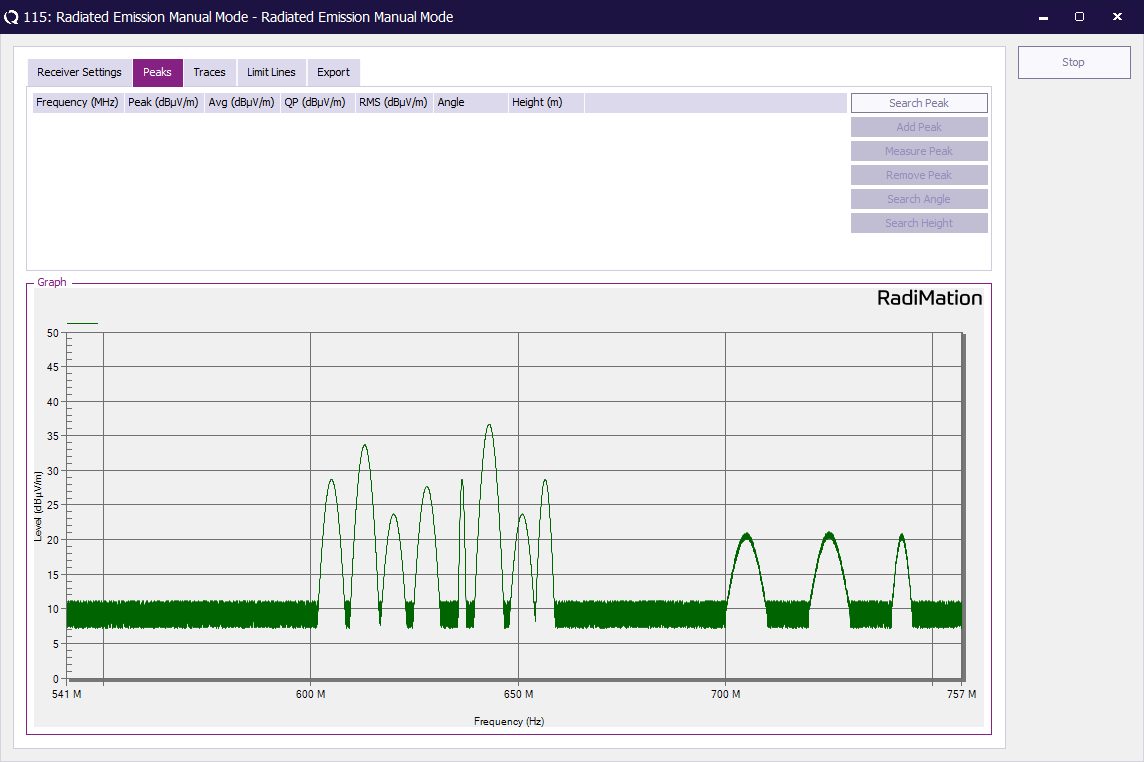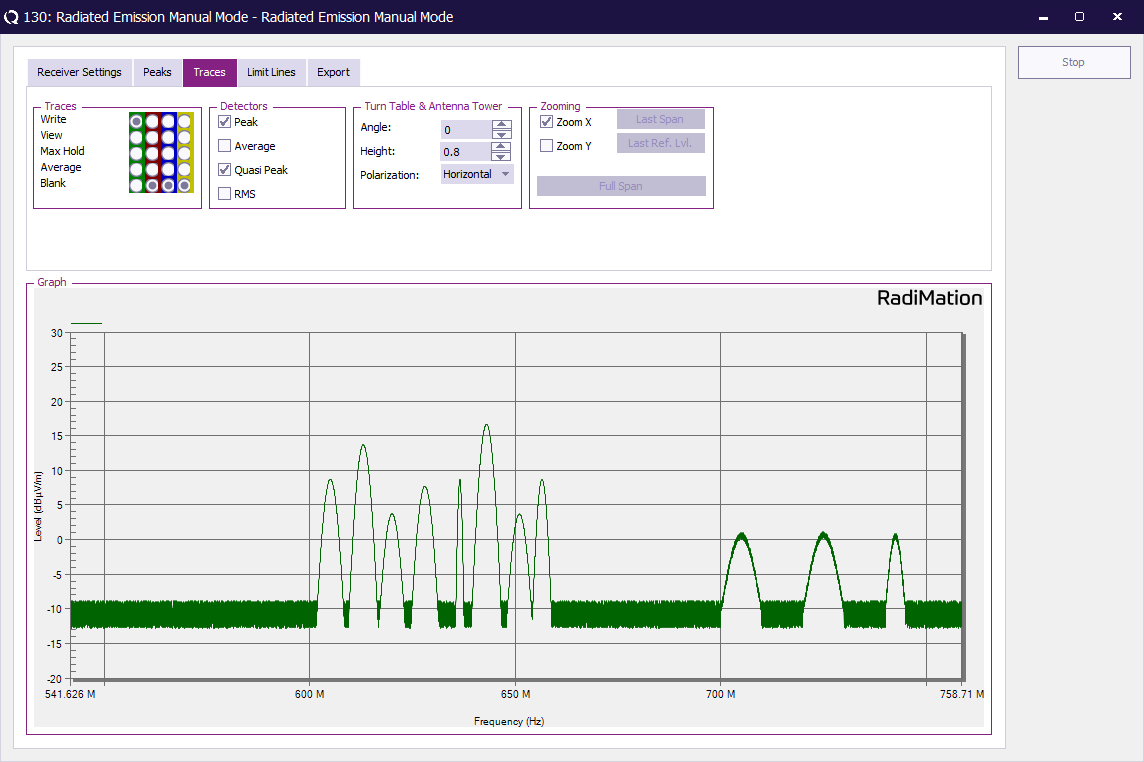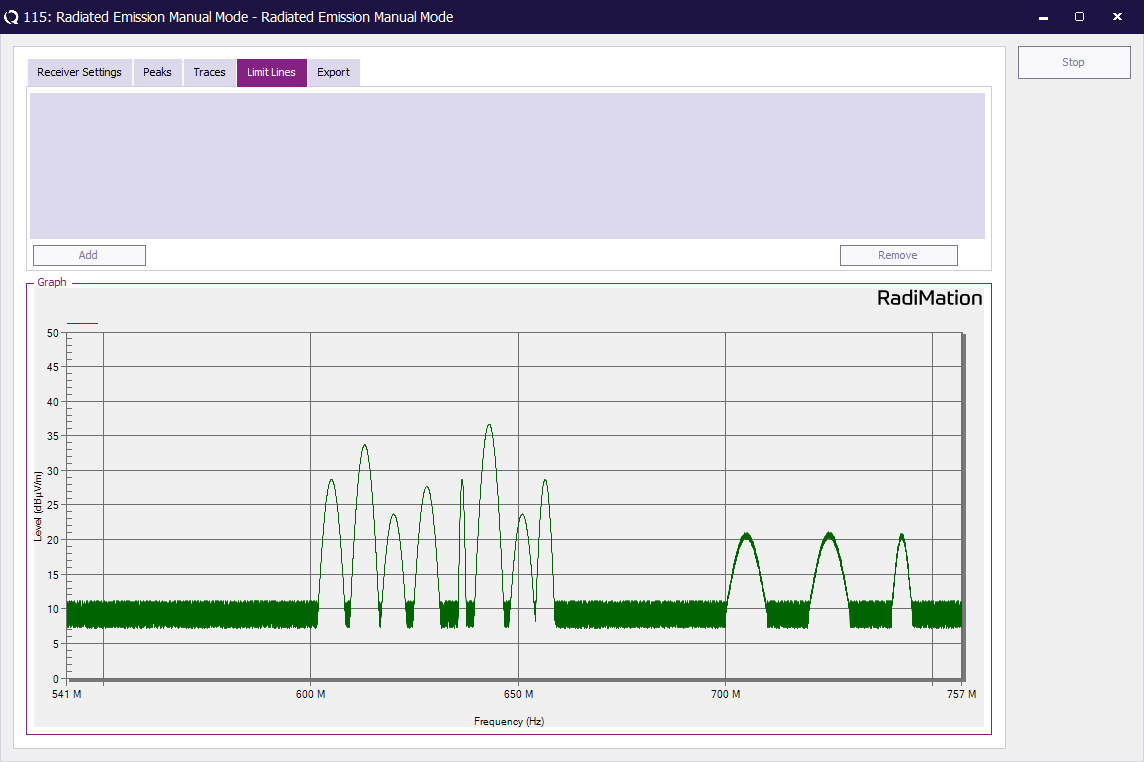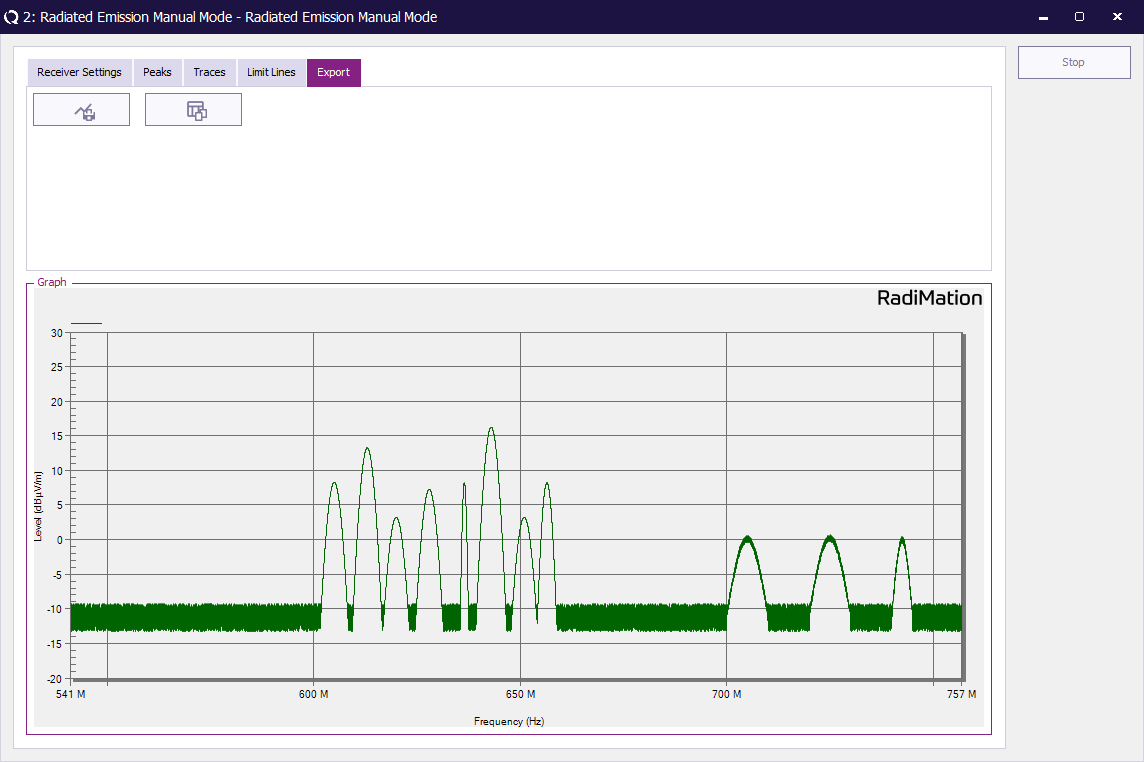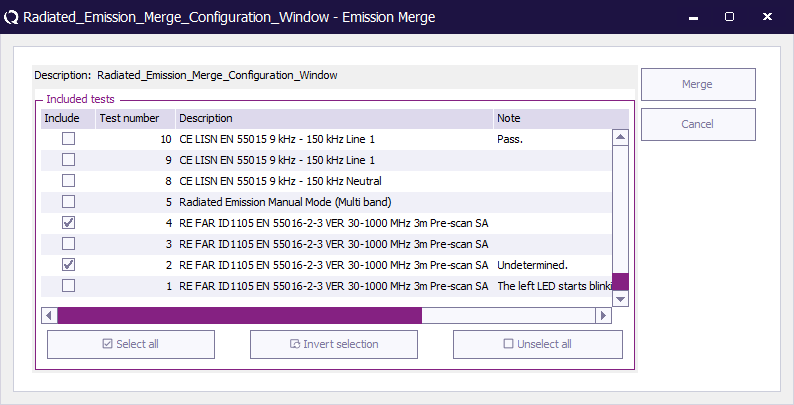Chapter 7: Difference between revisions
| (121 intermediate revisions by 4 users not shown) | |||
| Line 4: | Line 4: | ||
==Introduction== | ==Introduction== | ||
The | The {{RadiMation}} package supports several different radiated emission methods: | ||
*Anechoic chamber | |||
*Fixed height | * [[#Multiband|Multiband]] | ||
* | * [[#Manual Mode|Manual Mode]] | ||
* Burst | |||
* [[#Anechoic chamber|Anechoic chamber]] | |||
* [[#Fixed height|Fixed height]] | |||
* [[#GTEM|GTEM]] | |||
* Mil Std Magnetic | |||
* [[#Manual mode (Singleband)|Manual mode (Singleband)]] | |||
* [[#Merge|Merge]] | |||
* [[#X + k * S|X + k * S]] | |||
These methods are described in the subsequent paragraphs. | These methods are described in the subsequent paragraphs. | ||
==Starting a radiated emission test== | |||
===Loading a TSF file=== | |||
To start a radiated emission test, an EUT file must be defined first. From the EUT file, select: {{Menu|Tests|Radiated Emission}} and then the desired test method. | |||
A list of Technical Setup Files (TSF files) will be displayed. The test engineer can select one of these TSF files to load all parameters from a previously defined emission test or press {{ScreenElement|New}} to define a new emission test. | |||
[[File:SelectTSF REMultiband.png]] | |||
After the TSF file has been selected, the emission configuration window will appear. | |||
When a TSF file is loaded, all test parameters will be already configured and pressing the {{ScreenElement|Start Test}} button on the right side of the screen will start the radiated emission test. | |||
When no TSF file is loaded (by pressing {{ScreenElement|New}} in the TSF selection window) all parameters will be at zero and can be configured by the operator. | |||
===Test initialisation and self test=== | |||
When the {{ScreenElement|Start Test}} button is pressed, the software first runs a number of checks. | |||
# The presence of a valid software key is checked. | |||
# The software settings are checked (i.e. is all test equipment used within its parameters?) | |||
# The presence of all test equipment is checked. | |||
# All relevant equipment will be initialised. | |||
When one or more of the tests mentioned above fail, an error message is displayed. | |||
===Test results screen=== | |||
You can access the test results of the performed test by selecting the test in the EUT window and then press the {{ScreenElement|Info}} button. | |||
For the Multiband test, the window that is appearing looks a lot like the manual mode screen, the reason that it looks the same is because it is. You can continue testing after you finished a test, just select the testsite you want to use and you can continue testing. | |||
{{Note|The pass/fail criteria, shown in the tables do not take the measure uncertainty of the test setup into account.}} | |||
{{Note|Continuing the test is only possible with the selected test site. {{RadiMation}} will not select the correct test site for you. All measurements are done with the selected test site. If you want automatic changes of the test site, restart the configured TSF file.}} | |||
===Testsite information=== | |||
An radiated emission test, requires that a testsite is used that can have the following components. | |||
[[Image:Radiated Emission Test Setup Chamber.png]] | |||
{|class="wikitable" | |||
!# || Device name || Tab in {{RadiMation}} configuration window | |||
|- | |||
| ||Spectrum analyser || Devices 2 | |||
|- | |||
| ||Pre amplifier || Devices 2 | |||
|- | |||
| ||Antenna || Devices 1 | |||
|- | |||
| ||Turn table || Devices 1 | |||
|- | |||
| ||Antennatower || Devices 1 | |||
|- | |||
!colspan="3" |'''Cables''' | |||
|- | |||
|1 || Cable preamp -> analyser || Cables | |||
|- | |||
|2 || Cable antenna -> preamp|| Cables | |||
|} | |||
{{Note|Usage of cable correction factors is not mandatory. However, using cable correction factors will increase measurement accuracy during emission measurements. When in doubt contact your reseller.}} | |||
== Multiband == | |||
The radiated emission Multiband test, is a very flexible and powerful test to perform radiated emission tests. | |||
When the multiband test is performed, it will first perform a prescan measurement on all the specified locations. After this prescan is finished the temporary results are shown, and some peaks are automatically detected and shown. At this moment those peaks are NOT measured yet with the final measurement detectors and are also not optimized yet. The end-user now has the possibility to add additional peaks, or do some other peak investigation/changes. | |||
When the end-user is satisfied with the list of detected peaks, he can continue with the final measurement, by pressing the {{ScreenElement|Automatic}} button again. | |||
When the end-user has configured peak optimization to be active, the peak optimization will now also be performed. | |||
Now the peaks will be measured with the detector that are selected in the {{ScreenElement|Final peak measurement}} box. Only after those measurements are finalized, those detector values will become available in the list of detected peaks. | |||
[[Image:Radiated Emission Multi Band Configuration Window.png]] | |||
The test engineer can configure a complete radiated emission test in the Radiated Emission configuration menu. The test engineer can change the frequency range from one frequency band or the RBW of several bands. It all depends on the selection of bands. When several bands are selected and some options are blank, this means that these settings in bands are different. For example if the test engineer selects both frequency band in the window above, the frequency range will be blank. If the engineer sets the start and stop frequency, all the selected bands will have the same frequency setting. One of the advantages of this feature is the quick settings of several settings like the RBW or the peak detection. | |||
===Frequency window=== | |||
[[Image:Radiated Emission Multi Band Bands Window.png]] | |||
In the frequency window, the test engineer can enter a frequency range to be measured. | |||
Pressing {{ScreenElement|Add}} will add a new frequency band to the test, {{ScreenElement|Remove}} will remove all the selected bands and {{ScreenElement|Duplicate}} will duplicate all selected bands. | |||
===Turntable window=== | |||
[[Image:Radiated Emission Multi Band Turntable Angle Window.png]] | |||
In the turntable window, the following parameters can be configured: | |||
{{ScreenElementDescription|Start Angle|Sets the start position of the turntable.}} | |||
{{ScreenElementDescription|End Angle|Sets the stop position of the turntable.}} | |||
{{ScreenElementDescription|Steps|Sets the number of steps for one turntable rotation.}} | |||
{{ScreenElementDescription|Turn during measurements|This will force the turntable to continuously rotate during the test and will disable steps setting.}} | |||
{{ScreenElementDescription|EUT angle offset|The offset of the EUT compared to the zero angle of the table.}} | |||
{{ScreenElementDescription|Optimize Angle|Optimized settings for searching the correct angle.}} | |||
===Turntable window optimize angle settings=== | |||
[[Image:Radiated Emission Multi Band Optimized Angle Settings Window.png]] | |||
When optimize angle is selected, the user can configure the way a peak search is performed. | |||
In the optimize angle configuration window, the following configurations can be made: | |||
{{ScreenElementDescription|Area|Range over which the peak search will be performed (0 to 360 degrees max.).}} | |||
{{ScreenElementDescription|Step size|The angle step size.}} | |||
The area is defined 50% left of the starting position and 50% right. So if the area is 30 degrees, {{RadiMation}} will scan between starting position plus and minus 15 degrees. | |||
In the detector window the test engineer can select which detectors to use for measuring the optimal angle. | |||
After selecting the detectors the measure time and observation time of the selected detector are enabled. It is possible to use other settings for finding the peak then the settings on the main configuration window. | |||
===Antenna tower window=== | |||
[[Image:Radiated Emission Multi Band Antenna Height Window.png]] | |||
In the antenna tower window, the following parameters can be configured: | |||
{{ScreenElementDescription|Max. height|Sets maximum height of the antenna tower.}} | |||
{{ScreenElementDescription|Min. height|Sets the minimum height of the antenna tower.}} | |||
{{ScreenElementDescription|Steps|Sets the number of steps to go from min. height to max. height.}} | |||
{{ScreenElementDescription|Move during measurements|This will force the Antenna Tower to continuously move during the test and will disable steps setting.}} | |||
{{ScreenElementDescription|Optimize height|The software will automatically detect on which antenna height maximum emission will occur.}} | |||
When Optimize height is selected, the user can configure the way a peak search is performed. | |||
===Optimize height settings=== | |||
[[Image:Radiated Emission Multi Band Optimized Height Settings Window.png]] | |||
When optimize height is selected, the user can configure the way a peak search is performed. | |||
In the optimize height configuration window, the following configurations can be made: | |||
{{ScreenElementDescription|Area|Range over which the peak search will be performed (0 to Max height).}} | |||
{{ScreenElementDescription|Step size|The height step size.}} | |||
The area is defined 50% above of the starting position and 50% below. So if the area is 1 meter, {{RadiMation}} will scan between starting position plus and minus 50 cm. | |||
In the detector window the test engineer can select which detectors to use for measuring the optimal height. After selecting the detectors the measure time and observation time of the selected detector are enabled. It is possible to use other settings for finding the peak then the settings on the main configuration window. | |||
===Antenna window=== | |||
[[Image:Radiated Emission Multi Band Antenna Settings Window.png]] | |||
====Polarisation==== | |||
In the antenna window the user can select the antenna polarisation. The test engineer can select the following three options: | |||
# Horizontal | |||
# Vertical | |||
# Both | |||
When Horizontal or Vertical is selected, the software will measure only one antenna polarisation. When the option “Both” is selected, the software will measure both Horizontal and Vertical polarisation (an antenna positioner is required for this option). | |||
When this option is selected, all data will be displayed in one graph thus loosing some polarisation information. However the peak list table will show if a peak was measured in horizontal or vertical polarisation. | |||
If the both emission graphs of horizontal and vertical polarisation are required, two separate tests must be configured. These tests can be put in a sequence, eliminating the need for a user intervention. | |||
====Distance==== | |||
{{RadiMation}} uses the distance information for reference only. | |||
===Receiver settings=== | |||
[[Image:Radiated Emission Multi Band Receiver Settings Window.png]] | |||
{{ScreenElementDescription|Reference level|Sets the reference level of the receiver.}} | |||
{{ScreenElementDescription|Attenuator|Sets the receiver attenuator level.}} | |||
{{ScreenElementDescription|RBW|Sets the Resolution Band Width filter.}} | |||
{{ScreenElementDescription|VBW|Sets the Video Band Width filter.}} | |||
{{ScreenElementDescription|Sweep|Sets the sweep time of the receiver.}} | |||
{{ScreenElementDescription|Step frequency|Sets the frequency step size of the receiver.}} | |||
{{ScreenElementDescription|Measure time|Sets the measure time of the receiver.}} | |||
{{ScreenElementDescription|Pre-amp|Sets the pre-amp gain.}} | |||
When a parameter is set to auto, {{RadiMation}} will determine the most optimum settings for this parameter. If the parameter is set to coupled, the parameter will be set to automatic internally in the receiver. | |||
===Traces window=== | |||
[[Image:Radiated Emission Multi Band Traces Settings Window.png]] | |||
In the traces window, the test engineer can select a maximum of four traces, which can be measured and displayed at the same time. | |||
{{ScreenElementDescription|Detectors|The detector settings (Peak, Average, Quasi-peak, RMS) used during sweeptime. This setting is generic. So it is possible to select multiple detectors, but only one detector can be selected due to the device limitations. In that case for each enabled detector the amount of sweeps will be performed by {{RadiMation}}.}} | |||
{{ScreenElementDescription|Number of sweeps|The number op peak hold sweeps for each measurement can be selected. If this value is set to, for example 10, the software will measure the frequency band 10 times for each turntable and antenna tower position. This value will normally be set to 1 for measurement receivers while a higher value is used for spectrum analysers. The amount of required peak sweeps is depending on the type of signal and the setting of the sweep speed. For spectrum analysers and CW signals you can use a relatively low amount of peak sweeps, for example 10. But when you have discontinues signals like a spark bridge, you may need 100 peak sweeps or more. A good indication if you are using enough peak sweeps is to look at the envelope of the frequency spectrum. When it has gaps or jumps then you are not using enough sweeps to determine a correct signal envelope.}} | |||
===Final peak measurement=== | |||
[[Image:Radiated Emission Multi Band Final Peak Measurement Settings Window.png]] | |||
In the final peak measurement window the test engineer can configure the detectors used during the final emission measurements of the detected peaks. The first value is the time constant of the detector while the second value is used for the measure time at each frequency point for this detector. The time constant is send to the receiver, to set the sample time of the detector. To select a detector, check the desired button. | |||
===Peak detection window=== | |||
[[Image:Radiated Emission Multi Band Peak Detection Settings Window.png]] | |||
{{ScreenElementDescription|No peaks|When no final peak measurements are required select the option no peaks.}} | |||
{{ScreenElementDescription|Maximum Peaks|With the max. peaks option, the user can limit the number of peak signals the software will detect and re-measure.}} | |||
===Test site window=== | |||
[[Image:Radiated Emission Multi Band Test Site Settings Window.png]] | |||
{{ScreenElementDescription|Test equipment|In the test site window the test engineer can select which equipment list will be used during this test.}} | |||
It is possible to use different test equipment for every configured frequency band. | |||
{{ScreenElementDescription|Equipment icon|By clicking on the equipment icon, the equipment list can be viewed and edited.}} | |||
===Limit lines window=== | |||
[[Image:Radiated Emission Multi Band Limit Lines Settings Window.png]] | |||
In the limit line window the operator select one or more limit lines to be used during the test. | |||
{{ScreenElementDescription|All peaks above “xx” below the limit lines|In the peak detection window, the test engineer can configure which signal peaks must be detected. If the operator selects a value of 5 dB, the software will detect all peaks, which are higher than 5 dB below the limit line.}} | |||
===Change Order window=== | |||
[[Image:Radiated Emission Multi Band Change Order Settings Window.png]] | |||
In some case you want to switch for example the antenna height scan before the turn table scan because this will decrease the total measuring time. With the change order the test engineer can control the way {{RadiMation}} performs the testing sequence. Read the list from top to bottom to see what changes first. The best way explain the change order window is by example. | |||
[[Image:Radiated Emission Multi Band Band A Band B.png]] | |||
You need to perform a test as shown but you have 2 test sites. One with an antenna with the frequency range that is equal to the total band. The second test site you have 2 antennas, one for every frequency band. For test site one you want the RBW filter to change as little as possible to prevent the old analyser from breaking down. | |||
So for Site 1 you want: | |||
*Band A RBW 9 kHz | |||
*Band B RBW 9 kHz | |||
*Band A RBW 120 kHz | |||
*Band B RBW 120 kHz | |||
And for test site 2: | |||
*Band A RBW 9 kHz | |||
*Band A RBW 120 kHz | |||
*Band B RBW 9 kHz | |||
*Band B RBW 120 kHz | |||
For test site one, we do not have to change the order. Why? you may wonder. The explanation is quite easy. Look at the frequency change list, first change frequency band then change RBW. That is exactly what you want. Let check what the software is going to do: | |||
*Band A RBW 9 kHz | |||
*Band B RBW 9 kHz | |||
*Band B RBW 120 kHz | |||
*Band A RBW 120 kHz | |||
This is even better then we had hoped for, the amount of switching has been decrees due to the fact that {{RadiMation}} detected that it had to measure the same frequency twice. | |||
For test site two, it is a bit more complicated. You might wonder why? It looks easy just put the RBW in front the Frequency band and you are done. So far you are correct, but a different antenna also means a different test site. So changing the test site should also be above frequency band. When doing so, lets check it again. The top three settings: | |||
*RBW | |||
*Testsite | |||
*Frequency band | |||
In words again, first change the RBW then the test site and then the frequency band. | |||
*Band A RBW 9 kHz | |||
*Band A RBW 120 kHz | |||
*Band B RBW 120 kHz | |||
*Band B RBW 9 kHz | |||
This is also better then we had hoped for, the amount of switching has been decrees due to the fact that {{RadiMation}} detected that it had to measure the same RBW twice. | |||
{{Note|If you have any questions regarding the setting of the change order please contact your reseller.}} | |||
== Manual Mode == | |||
[[Image:Radiated Emission Manual Mode Multi Band Test.png]] | |||
===Receiver settings=== | |||
[[Image:Radiated Emission Multi Band Manual Mode Receiver Window.png]] | |||
With receiver settings the test engineer has full control over the analyser/receiver. Depending on the personal taste the frequency range can be set using in Center/span or start/stop mode. The rest of the settings speak for themselves except the buttons on the bottom. The test engineer can use them to select which type traces should be used to measure the spectrum. For configuring the detectors used during final measurement see chapter “Final measurement”. | |||
===Turn table=== | |||
[[Image:Radiated Emission Multi Band Manual Mode Turn Table Window.png]] | |||
The turn table settings are directly linked to the turn table. Meaning that when a test engineer changes one of the settings then {{RadiMation}} will apply this setting directly. | |||
===Antenna tower=== | |||
[[Image:Radiated Emission Multi Band Manual Mode Antenna Tower Window.png]] | |||
The antenna tower settings are directly linked to the antenna tower. Meaning that when a test engineer changes one of the settings then {{RadiMation}} will apply this setting directly. | |||
===Test site=== | |||
[[Image:Radiated Emission Multi Band Manual Mode Test Site Window.png]] | |||
Before manual mode can be used the test site needs to be selected so that {{RadiMation}} knows which devices to use. | |||
===Final measurement=== | |||
[[image:Radiated Emission Multi Band Final Peak Measurement Settings Window.png]] | |||
In the final peak measurement window the test engineer can configure the detectors used during the final emission measurements of the peaks. The first value is the time constant of the detector while the second value is used for the measure time at each frequency point for this detector. The time constant is send to the receiver, to set the sample time of the detector. To select a detector, check the desired button. | |||
===Peaks window=== | |||
[[Image:Radiated Emission Multi Band Manual Mode Peaks Window.png]] | |||
{{ScreenElementDescription|Max Peaks|Maximum allowed amount of peaks to be automatically determined.}} | |||
{{ScreenElementDescription|Detect Peaks|Detects the configured amount of sweeps in the measured spectrum.}} | |||
{{ScreenElementDescription|Measure Peaks|Measures all selected peaks with the configured settings in the final measurement window.}} | |||
{{ScreenElementDescription|Peak Actions|Allows several actions to be performed on the detected peaks, like select all and deselect all. | |||
{{ScreenElementDescription|Peaks to maximum|Start performing measurement to redetermine on which turntable angle and antenna tower height the highest emission value was measured. | |||
This angle and height will be updated in the selected peak, together with the corresponding measured emission values. If multiple peaks are selected, this search for the highest emission value is done individually for every selected peak. | |||
This 'peaks to maximum' function can be very helpful during the angle or height optimization of a peak. If after manual changes of the antenna height or turntable angle, no other maximum is found, the peak can be reset to the angle and height where the maximum was determined. 'Peaks to maximum', will thus select that location on which the highest emission value was measured. | |||
}} | |||
{{ScreenElementDescription|Measure Peaks|Start performing a final measurement on the selected peaks.}} | |||
{{ScreenElementDescription|Optimize Angle|Start performing a measurement as configured for the Optimize Angle.}} | |||
{{ScreenElementDescription|Optimize Height|Start performing a measurement as configured for the Optimize Height.}} | |||
{{ScreenElementDescription|Go To Peak Location|If possible it will adjust the Antenna Tower and Turntable to the location of the selected peak.}} | |||
{{ScreenElementDescription|Set receiver to Peak settings|Set the current receiver settings to the used settings of the selected peak.}} | |||
{{ScreenElementDescription|Configure -> Optimize Angle|Opens a new window to configure the Optimize Angle settings. (See also Optimize Angle settings.)}} | |||
{{ScreenElementDescription|Configure -> Optimize Height|Opens a new window to configure the Optimize Height settings. (See also Optimize height settings.)}} | |||
{{ScreenElementDescription|Delete peaks|Delete selected peak(s).}} | |||
}} | |||
{{ScreenElementDescription|Delete Peaks|Delete the selected peaks from the list.}} | |||
{{ScreenElementDescription|Sweeps|Amount of sweeps to be measured.}} | |||
{{ScreenElementDescription|Take Sweeps|Triggers the receiver of analyser to take the configured amount of sweeps.}} | |||
{{ScreenElementDescription|Continuous Measure|Start performing of taking measurements. This is a heavy process and it is normal when more CPU is used by the computer.}} | |||
{{ScreenElementDescription|Continuous Measure Write|Each new measurement will overwrite the previous measurement data.}} | |||
{{ScreenElementDescription|Continuous Measure Max-hold|Only higher new measurement values will overwrite the previous measurement data.}} | |||
{{ScreenElementDescription|Clear measurement data|Removes all previous measurement data.}} | |||
==Anechoic chamber== | ==Anechoic chamber== | ||
| Line 29: | Line 364: | ||
===Turntable window=== | ===Turntable window=== | ||
In the turntable window, the end-user can select the start and stop position of the turntable and the number of steps for the turntable. | |||
In the turntable window, the | |||
{{ScreenElementDescription|Start position|Sets the start angle of the turntable.}} | {{ScreenElementDescription|Start position|Sets the start angle of the turntable.}} | ||
{{ScreenElementDescription|Stop position|Sets the stop angle of the turntable.}} | {{ScreenElementDescription|Stop position|Sets the stop angle of the turntable.}} | ||
{{ScreenElementDescription|#| | {{ScreenElementDescription|#|Number of locations from {{ScreenElement|Start postion}} to {{ScreenElement|Stop position}} that should be measured.}} | ||
{{ScreenElementDescription|Peak search|The software will automatically detect on which angle maximum | {{ScreenElementDescription|Peak search|The software will automatically detect on which turntable angle the maximum measurement value of each peak is present.}} | ||
When | It is not required to have a turntable selected while performing the measurement. In this configuration there are two possibilities related to the selected turntable device in the the selected test-site. | ||
In the peak search configuration window, the following configurations can be made: | *If a turntable device is specified in the selected test-site, {{RadiMation}} will control the turntable to turn to the specified angle. | ||
*If no turntable device is specified in the selected test-site, {{RadiMation}} will assume that the EUT is already positioned on that specified angle. No actions on the turntable will be taken. | |||
As long as a single angle is measured, and no turntable device is specified in the test-site, it is possible to use the Multiband Radiated Emission test without a turntable. | |||
So, if you specify the same {{ScreenElement|Start position}} and {{ScreenElement|Stop position}}, and specify '1' to the number of steps ({{ScreenElement|#}}), then the test will assume that only that single specified angle should be measured. | |||
When {{ScreenElement|Peak search}} is selected, the user can configure the method that is used during the peak search. In the peak search configuration window, the following configurations can be made: | |||
{{ScreenElementDescription|Area|Range over which the peak search will be performed. The initially detected turntable angle of the peak will be the middle of this {{ScreenElement|Area}}, and the total search area for this peak will be half of this area clockwise and half of this area counter-clockwise.}} | |||
{{ScreenElementDescription|Step size|The step size for each turntable movement.}} | |||
{{ScreenElementDescription|Threshold|This value is only used during the {{ScreenElement|Intelligent}} mode. It influences how long the movement is continued. The movement will stop when the measurement value is lower than the specified {{ScreenElement|Threshold}} below the highest known measurement value of the searched peak.}} | |||
{{ScreenElementDescription|Mode|The mode setting determines the way a peak is detected. The following modes are available: | |||
* {{ScreenElement|Intelligent}} | |||
* {{ScreenElement|Complete area}} | |||
The Intelligent mode has the advantage that it stops with the scan as soon as a maximum measurement value has been determined. This could improve overall testtime as less movement of the turntable angle is possible. The Complete area mode has the advantage that the complete specified {{ScreenElement|Area}} is measured. | |||
}} | |||
====Intelligent==== | ====Intelligent==== | ||
In this mode the software increases the angle of the turntable from the initial point with a step equal to {{ScreenElement|Step size}} as long as the measurement value is not more than {{ScreenElement|Threshold}} below the already known maximum measurement value. As soon as measurement value is detected that is {{ScreenElement|Threshold}} below the already known meaximum value, the turntable movement is reversed until the initial point and from this initial point the angle of the turntable is decreased with a step equal to {{ScreenElement|Step size}} until a measurement value is measured that is {{ScreenElement|Threshold}} below the already known maximum measurement value. The step on which the highest measurement value is measured, will be the optimum peak search location that is found for that peak. | |||
{{Warning|This might cause a measurement error if the intial number of steps ({{ScreenElement|#}}) is set to a low value.}} | |||
{{Warning|This might cause a measurement error if the number of steps is set to a low value.}} | |||
====Complete area==== | ====Complete area==== | ||
In this mode the complete area around the initial point and defined by {{ScreenElement|Area}} is scanned for a peak. The turntable angle is moved to one end of the to be measured area, and is then moved with the specified {{ScreenElement|Step size}} to the other end of the to be measured area. On each step the measurement value is determined, and the step on which the highest measurement value is measured, will be the optimum peak search location that is found for that peak. | |||
{{Warning|This might cause a measurement error if the {{ScreenElement|Area}} is set to a smaller value than the original stepsize (given by the stop position minus start position divided by the number of steps).}} | |||
{{Warning|This might cause a measurement error if the | |||
===Antenna tower window=== | ===Antenna tower window=== | ||
In the antenna tower window, the end-user can select the start and stop position of the antenna tower and the number of steps for the antenna tower. | |||
In the antenna tower window, the | |||
{{ScreenElementDescription|Max. height|Sets maximum height of the antenna tower.}} | {{ScreenElementDescription|Max. height|Sets maximum height of the antenna tower.}} | ||
{{ScreenElementDescription|Min. height|Sets the minimum height of the antenna tower.}} | {{ScreenElementDescription|Min. height|Sets the minimum height of the antenna tower.}} | ||
{{ScreenElementDescription|#| | {{ScreenElementDescription|#|Number op locations from {{ScreenElement|Max. height}} to {{ScreenElement|Min. height}} that should be measured.}} | ||
{{ScreenElementDescription|Peak search|The software will automatically detect on which antenna height maximum | {{ScreenElementDescription|Peak search|The software will automatically detect on which antenna height the maximum measurement value of each peak is present.}} | ||
When {{ScreenElement|Peak search}} is selected, the user can configure the method that is used during the peak search. In the peak search configuration window, the following configurations can be made: | |||
{{ScreenElementDescription|Area|Range over which the peak search will be performed. The initially detected antenna height of the peak will be the middle of this {{ScreenElement|Area}}, and the total search area for this peak will be half of this area up and half of this area down.}} | |||
{{ScreenElementDescription|Step size|The step size for each antenna height movement.}} | |||
{{ScreenElementDescription|Threshold|This value is only used during the {{ScreenElement|Intelligent}} mode. It influences how long the movement is continued. The movement will stop when the measurement value is lower than the specified {{ScreenElement|Threshold}} below the highest known measurement value of the searched peak.}} | |||
{{ScreenElementDescription|Mode|The mode setting determines the way a peak is detected. The following modes are available: | |||
* {{ScreenElement|Intelligent}} | |||
* {{ScreenElement|Complete area}} | |||
The Intelligent mode has the advantage that it stops with the scan as soon as a maximum measurement value has been determined. This could improve overall testtime as less movement of the antenna tower is possible. The Complete area mode has the advantage that the complete specified {{ScreenElement|Area}} is measured. | |||
}} | |||
====Intelligent==== | ====Intelligent==== | ||
In this mode the software increases the height of the antenna from the initial point with a step equal to {{ScreenElement|Step size}} as long as the measurement value is not more than {{ScreenElement|Threshold}} below the already known maximum measurement value. As soon as measurement value is detected that is {{ScreenElement|Threshold}} below the already known meaximum value, the antenna movement is reversed until the initial point and from this initial point the distance of the clamp is decreased with a step equal to {{ScreenElement|Step size}} until a measurement value is measured that is {{ScreenElement|Threshold}} below the already known maximum measurement value. The step on which the highest measurement value is measured, will be the optimum peak search location that is found for that peak. | |||
{{Warning|This might cause a measurement error if the intial number of steps ({{ScreenElement|#}}) is set to a low value.}} | |||
{{ | |||
====Complete area==== | ====Complete area==== | ||
In this mode the complete area around the initial point and defined by {{ScreenElement|Area}} is scanned for a peak. The antenna is moved to one end of the to be measured area, and is then moved with the specified {{ScreenElement|Step size}} to the other end of the to be measured area. On each step the measurement value is determined, and the step on which the highest measurement value is measured, will be the optimum peak search location that is found for that peak. | |||
{{Warning|This might cause a measurement error if the {{ScreenElement|Area}} is set to a smaller value than the original stepsize (given by the stop position minus start position divided by the number of steps).}} | |||
{{ | |||
===Antenna window=== | ===Antenna window=== | ||
| Line 107: | Line 448: | ||
====Distance==== | ====Distance==== | ||
RadiMation uses the distance information for reference only. | {{RadiMation}} uses the distance information for reference only. | ||
===Receiver settings=== | ===Receiver settings=== | ||
| Line 120: | Line 461: | ||
{{ScreenElementDescription|Measure time|Sets the measure time of the receiver}} | {{ScreenElementDescription|Measure time|Sets the measure time of the receiver}} | ||
When a parameter is set to auto, | When a parameter is set to auto, {{RadiMation}} will determine the most optimum settings for this parameter. If the parameter is set to coupled, the parameter will be set to automatic internally in the receiver. | ||
However, using the 'Auto' setting for the attenuator can let the analyser decides to use a different attenuator setting during (re-)measuring of a peak, which as a result can lead to measuring a higher Quasi-Peak value than the Peak value. This is related to the used analyser when auto attenuator is used. If it is not desired that the analyser can decide to switch to a different attenuator setting, then this should be disabled by the test engineer in {{RadiMation}} by using a fixed attenuator value. | |||
{{Warning| All these settings are generic. Therefore, always verify that the configured settings are also supported by the used hardware to ensure it is correctly used and no measurement faults are introduced. Use a fixed value to disabled interference of equipment intelligence.}} | |||
===Max. hold measurements=== | ===Max. hold measurements=== | ||
In this window the number | In this window the number of peak hold sweeps for each measurement can be selected. If this value is set to, for example 10, the software will measure the frequency band 10 times for each turntable and antenna tower position. This value will normally be set to 1 for measurement receivers while a higher value is used for spectrum analysers. The amount of required peak sweeps is depending on the type of signal and the setting of the sweepspeed. For spectrum analysers and CW signals you can use a relatively low amount of peaksweeps, for example 10. But when you have discontinues signals like a spark bridge, you may need 100 peaksweeps or more. A good indication if you are using enough peak sweeps is to look at the envelope of the frequency spectrum. When it has gaps or jumps then you are not using enough sweeps to determine a correct signal envelope. | ||
===Traces window=== | ===Traces window=== | ||
| Line 130: | Line 475: | ||
===Detectors window=== | ===Detectors window=== | ||
In the detectors window the test engineer can configure the detectors used during the final emission measurements of the detected peaks. The first value is the time constant of the detector while the second value is used for the measure time at each frequency point for this detector. The time constant is send to the receiver, to set the sample time of the detector. To select a detector, check the desired box. | |||
In the detectors window the test engineer can configure the detectors used during the emission measurements. The first value is the time constant of the detector while the second value is used for the measure time at each frequency point for this detector. The time constant is send to the receiver, to set the sample time of the detector. To select a detector, check the desired box. | |||
===Peak detection window=== | ===Peak detection window=== | ||
| Line 155: | Line 499: | ||
{{ScreenElementDescription|Record data|In the test options window the operator can select whether all RAW data must be stored or only the measurement results are stored. It should be noted that for full tracebility, all test data should be stored.}} | {{ScreenElementDescription|Record data|In the test options window the operator can select whether all RAW data must be stored or only the measurement results are stored. It should be noted that for full tracebility, all test data should be stored.}} | ||
{{ScreenElementDescription|Narrow band / broad band discrimination| | {{ScreenElementDescription|Narrow band / broad band discrimination|{{RadiMation}} supports two types of narrow band / broad band determination.}} | ||
The first one is called | The first one is called 'Generic'. During the determination of the peak, the so called ‘zooming’. {{RadiMation}} verifies if the peak is bigger or equal to twice the RBW filter. If so, the peak is determined broad band. Otherwise it is called narrow band. | ||
The second method is called | The second method is called 'Mil Standard'. This method is also based on the RBW filter. But now the filter is changed to determine the type of peak. First the peak is measured with the current RBW, then it is made 10 times bigger. If multiplying the current RBW gives a RBW that is bigger then 1 MHz the current RBW is divided by 10. A delta RBW is calculated according to the formula below. | ||
<math>Delta RBW = | <math>Delta RBW = 10 * log(\frac{RBW_1}{RBW_2})</math> | ||
{{Formula|7|1|Difference in a peak measurement, as a result of changing the used RBW}} | |||
Where RBW1 is the RBW used in the first measurement and RBW2 is used in the second measurement. Also a Delta V is calculated, V1 is the dbuV measured during the first measurement and V2 is voltage measured during the second measurement. | Where RBW1 is the RBW used in the first measurement and RBW2 is used in the second measurement. Also a Delta V is calculated, V1 is the dbuV measured during the first measurement and V2 is voltage measured during the second measurement. | ||
<math>DeltaV={V_1} | <math>DeltaV={V_1}\ -\ {V_2}</math> | ||
{{Formula|7|2|Difference in a peak amplitude}} | |||
Determination the type of peak is done according to the table below. | Determination the type of peak is done according to the table below. | ||
| Line 173: | Line 519: | ||
{| | {| | ||
!Limits || Distortion type | !Limits || Distortion type | ||
| | |- | ||
|Delta V <= 5 Delta RBW || Narrow band | |Delta V <= 5 Delta RBW || Narrow band | ||
| | |- | ||
|Delta V is > than 5 Delta RBW and delta V is <= 15 delta RBW || Random noise | |Delta V is > than 5 Delta RBW and delta V is <= 15 delta RBW || Random noise | ||
| | |- | ||
|Delta V > 15 delta RBW || Broad band | |Delta V > 15 delta RBW || Broad band | ||
|} | |} | ||
| Line 232: | Line 578: | ||
#The receiver takes the desired sweeps of the spectrum. | #The receiver takes the desired sweeps of the spectrum. | ||
{{RadiMation}} now performs a maxhold on all the sweeps and determines the peaks. | |||
Then it determines the position a peak was found. | Then it determines the position a peak was found. | ||
And changes the turntable and antenna to that current position to re-measure the peak. | And changes the turntable and antenna to that current position to re-measure the peak. | ||
| Line 239: | Line 585: | ||
Please note that the example above makes the assumption that there is an antenna tower and turntable controller. When either or neither of the controllers are available the test can still be performed except for the missing unit. When neither of the controllers are available the software performs the test on one point. | Please note that the example above makes the assumption that there is an antenna tower and turntable controller. When either or neither of the controllers are available the test can still be performed except for the missing unit. When neither of the controllers are available the software performs the test on one point. | ||
===Info screen=== | ===Info screen=== | ||
| Line 262: | Line 607: | ||
[[Image:Radiated Emission Test Setup Chamber.png]] | [[Image:Radiated Emission Test Setup Chamber.png]] | ||
{| | {|class="wikitable" | ||
!Device name || Tab in | !# ||Device name || Tab in {{RadiMation}} configuration window | ||
| | |- | ||
|Spectrum analyser || | | ||Spectrum analyser || Devices 2 | ||
| | |- | ||
|Pre amplifier || | | ||Pre amplifier || Devices 2 | ||
| | |- | ||
|Antenna || | | ||Antenna || Devices 1 | ||
|- | |||
!colspan="3"|'''Cables''' | |||
|- | |||
|1 || cable Preamp -> analyser || Cables | |||
|- | |||
|2 || cable Antenna -> Preamp || Cables | |||
|} | |} | ||
{{Note|Usage of cable correction factors is not mandatory. However, using correction factors will increase measurement accuracy during emission measurements. | |||
{{Note|Usage of cable correction factors is not mandatory. However, using correction factors will increase measurement | |||
When in doubt contact your reseller.}} | When in doubt contact your reseller.}} | ||
| Line 288: | Line 629: | ||
==Measurement of peak amplitude and peak frequency== | ==Measurement of peak amplitude and peak frequency== | ||
When using a spectrum analyser for emission measurements, | When using a spectrum analyser for emission measurements, {{RadiMation}} first performs a full span max. hold measurement with the configured trace detector. The number of max. hold peak sweeps can be defined by the user. From the obtained max hold graph, {{RadiMation}} determines a number of peaks, which will be further investigated. The number of peak signals to be measured can be defined by the user. For each peak from the graph, {{RadiMation}} will zoom in, by reducing the span in several steps. This must be done while span inaccuracy of the analyser in large frequency spans will give slightly incorrect frequency information. After the exact peak frequency is determined, {{RadiMation}} will perform the configured Peak,Quasi peak, Average and / or RMS measurements. Due to the above, the finally measured frequency and amplitude of a peak can slightly differ from the max hold graph. This is not an error, but merely an indication that the final measurements are more accurate. The peak table always shows the final measured values (most accurate). | ||
== Fixed height | == Fixed height == | ||
===Introduction=== | ===Introduction=== | ||
| Line 310: | Line 651: | ||
===Turntable window=== | ===Turntable window=== | ||
In the turntable window, the end-user can select the start and stop position of the turntable and the number of steps for the turntable. | |||
In the | |||
{{ScreenElementDescription|Start position|Sets the start angle of the turntable.}} | {{ScreenElementDescription|Start position|Sets the start angle of the turntable.}} | ||
{{ScreenElementDescription|Stop position|Sets the stop angle of the turntable.}} | {{ScreenElementDescription|Stop position|Sets the stop angle of the turntable.}} | ||
{{ScreenElementDescription|#| | {{ScreenElementDescription|#|Number of locations from {{ScreenElement|Start postion}} to {{ScreenElement|Stop position}} that should be measured.}} | ||
{{ScreenElementDescription|Peak search|The software will automatically detect on which angle maximum | {{ScreenElementDescription|Peak search|The software will automatically detect on which turntable angle the maximum measurement value of each peak is present.}} | ||
It is not required to have a turntable selected while performing the measurement. In this configuration there are two possibilities related to the selected turntable device in the the selected test-site. | |||
*If a turntable device is specified in the selected test-site, {{RadiMation}} will control the turntable to turn to the specified angle. | |||
*If no turntable device is specified in the selected test-site, {{RadiMation}} will assume that the EUT is already positioned on that specified angle. No actions on the turntable will be taken. | |||
As long as a single angle is measured, and no turntable device is specified in the test-site, it is possible to use the Multiband Radiated Emission test without a turntable. | |||
So, if you specify the same {{ScreenElement|Start position}} and {{ScreenElement|Stop position}}, and specify '1' to the number of steps ({{ScreenElement|#}}), then the test will assume that only that single specified angle should be measured. | |||
When {{ScreenElement|Peak search}} is selected, the user can configure the method that is used during the peak search. In the peak search configuration window, the following configurations can be made: | |||
{{ScreenElementDescription|Area|Range over which the peak search will be performed. The initially detected turntable angle of the peak will be the middle of this {{ScreenElement|Area}}, and the total search area for this peak will be half of this area clockwise and half of this area counter-clockwise.}} | |||
{{ScreenElementDescription|Step size|The step size for each turntable movement.}} | |||
{{ScreenElementDescription|Threshold|This value is only used during the {{ScreenElement|Intelligent}} mode. It influences how long the movement is continued. The movement will stop when the measurement value is lower than the specified {{ScreenElement|Threshold}} below the highest known measurement value of the searched peak.}} | |||
{{ScreenElementDescription|Mode|The mode setting determines the way a peak is detected. The following modes are available: | |||
* {{ScreenElement|Intelligent}} | |||
* {{ScreenElement|Complete area}} | |||
The Intelligent mode has the advantage that it stops with the scan as soon as a maximum measurement value has been determined. This could improve overall testtime as less movement of the turntable angle is possible. The Complete area mode has the advantage that the complete specified {{ScreenElement|Area}} is measured. | |||
}} | |||
{{ | |||
====Intelligent==== | ====Intelligent==== | ||
In this mode the software increases the angle of the turntable from the initial point with a step equal to {{ScreenElement|Step size}} as long as the measurement value is not more than {{ScreenElement|Threshold}} below the already known maximum measurement value. As soon as measurement value is detected that is {{ScreenElement|Threshold}} below the already known meaximum value, the turntable movement is reversed until the initial point and from this initial point the angle of the turntable is decreased with a step equal to {{ScreenElement|Step size}} until a measurement value is measured that is {{ScreenElement|Threshold}} below the already known maximum measurement value. The step on which the highest measurement value is measured, will be the optimum peak search location that is found for that peak. | |||
{{Warning|This might cause a measurement error if the intial number of steps ({{ScreenElement|#}}) is set to a low value.}} | |||
{{ | |||
====Complete area==== | ====Complete area==== | ||
In this mode the complete area around the initial point and defined by {{ScreenElement|Area}} is scanned for a peak. The turntable angle is moved to one end of the to be measured area, and is then moved with the specified {{ScreenElement|Step size}} to the other end of the to be measured area. On each step the measurement value is determined, and the step on which the highest measurement value is measured, will be the optimum peak search location that is found for that peak. | |||
{{Warning|This might cause a measurement error if the {{ScreenElement|Area}} is set to a smaller value than the original stepsize (given by the stop position minus start position divided by the number of steps).}} | |||
{{ | |||
===Antenna tower window=== | ===Antenna tower window=== | ||
In the antenna tower window, the end-user can select the start and stop position of the antenna tower and the number of steps for the antenna tower. | |||
In the antenna tower window, the | |||
{{ScreenElementDescription|Max. height|Sets maximum height of the antenna tower.}} | {{ScreenElementDescription|Max. height|Sets maximum height of the antenna tower.}} | ||
{{ScreenElementDescription|Min. | {{ScreenElementDescription|Min. height|Sets the minimum height of the antenna tower.}} | ||
{{ScreenElementDescription|#| | {{ScreenElementDescription|#|Number op locations from {{ScreenElement|Max. height}} to {{ScreenElement|Min. height}} that should be measured.}} | ||
{{ScreenElementDescription|Peak search|The software will automatically detect on which antenna height maximum | {{ScreenElementDescription|Peak search|The software will automatically detect on which antenna height the maximum measurement value of each peak is present.}} | ||
When {{ScreenElement|Peak search}} is selected, the user can configure the method that is used during the peak search. In the peak search configuration window, the following configurations can be made: | |||
{{ScreenElementDescription|Area|Range over which the peak search will be performed. The initially detected antenna height of the peak will be the middle of this {{ScreenElement|Area}}, and the total search area for this peak will be half of this area up and half of this area down.}} | |||
{{ScreenElementDescription|Step size|The step size for each antenna height movement.}} | |||
{{ScreenElementDescription|Threshold|This value is only used during the {{ScreenElement|Intelligent}} mode. It influences how long the movement is continued. The movement will stop when the measurement value is lower than the specified {{ScreenElement|Threshold}} below the highest known measurement value of the searched peak.}} | |||
{{ScreenElementDescription|Mode|The mode setting determines the way a peak is detected. The following modes are available: | |||
* {{ScreenElement|Intelligent}} | |||
* {{ScreenElement|Complete area}} | |||
The Intelligent mode has the advantage that it stops with the scan as soon as a maximum measurement value has been determined. This could improve overall testtime as less movement of the antenna tower is possible. The Complete area mode has the advantage that the complete specified {{ScreenElement|Area}} is measured. | |||
}} | |||
{{ | |||
====Intelligent==== | ====Intelligent==== | ||
In this mode the software increases the height of the antenna from the initial point with a step equal to {{ScreenElement|Step size}} as long as the measurement value is not more than {{ScreenElement|Threshold}} below the already known maximum measurement value. As soon as measurement value is detected that is {{ScreenElement|Threshold}} below the already known meaximum value, the antenna movement is reversed until the initial point and from this initial point the distance of the clamp is decreased with a step equal to {{ScreenElement|Step size}} until a measurement value is measured that is {{ScreenElement|Threshold}} below the already known maximum measurement value. The step on which the highest measurement value is measured, will be the optimum peak search location that is found for that peak. | |||
{{Warning|This might cause a measurement error if the intial number of steps ({{ScreenElement|#}}) is set to a low value.}} | |||
{{ | |||
====Complete area==== | ====Complete area==== | ||
In this mode the complete area around the initial point and defined by {{ScreenElement|Area}} is scanned for a peak. The antenna is moved to one end of the to be measured area, and is then moved with the specified {{ScreenElement|Step size}} to the other end of the to be measured area. On each step the measurement value is determined, and the step on which the highest measurement value is measured, will be the optimum peak search location that is found for that peak. | |||
{{Warning|This might cause a measurement error if the {{ScreenElement|Area}} is set to a smaller value than the original stepsize (given by the stop position minus start position divided by the number of steps).}} | |||
{{ | |||
===Antenna window=== | ===Antenna window=== | ||
| Line 393: | Line 736: | ||
====Distance==== | ====Distance==== | ||
In this box, the operator can enter the distance between antenna and EUT. RadiMation uses the distance information for reference only. | In this box, the operator can enter the distance between antenna and EUT. {{RadiMation}} uses the distance information for reference only. | ||
===Receiver settings=== | ===Receiver settings=== | ||
| Line 407: | Line 750: | ||
When a parameter is set to auto, RadiMation will determine the most optimum settings for this parameter. If the parameter is set to coupled, the parameter will be set to automatic internally in the receiver. | When a parameter is set to auto, {{RadiMation}} will determine the most optimum settings for this parameter. If the parameter is set to coupled, the parameter will be set to automatic internally in the receiver. | ||
===Max. hold measurements=== | ===Max. hold measurements=== | ||
| Line 418: | Line 761: | ||
===Detectors window=== | ===Detectors window=== | ||
In the detectors window the test engineer can configure the detectors used during the final emission measurements of the detected peaks. The first value is the time constant of the detector while the second value is used for the measure time at each frequency point for this detector. The time constant is send to the receiver, to set the sample time of the detector. To select a detector, check the desired box. | |||
In the detectors window the test engineer can configure the detectors used during the emission measurements. The first value is the time constant of the detector while the second value is used for the measure time at each frequency point for this detector. | |||
===Peak detection window=== | ===Peak detection window=== | ||
| Line 484: | Line 826: | ||
#The receiver takes the desired sweeps of the Spectrum. | #The receiver takes the desired sweeps of the Spectrum. | ||
{{RadiMation}} now performs a maxhold on all the sweeps and determines the peaks. | |||
Then it determines the position a peak was found. | Then it determines the position a peak was found. | ||
The turntable position is changes to that position to re-measure the peak. | The turntable position is changes to that position to re-measure the peak. | ||
| Line 496: | Line 838: | ||
{| | {|class="wikitable" | ||
!Device name || Tab in | !# ||Device name || Tab in {{RadiMation}} configuration window | ||
| | |- | ||
|Spectrum analyser || | | ||Spectrum analyser || Devices 2 | ||
| | |- | ||
|Pre amplifier || | | ||Pre amplifier || Devices2 | ||
| | |- | ||
|Antenna || | | ||Antenna || Devices 1 | ||
|- | |||
!colspan="3"|'''Cables''' | |||
|- | |||
|1 || cable amplifier ->Spectrum || Cables | |||
|- | |||
|2 || cable antenna ->Preamp || Cables | |||
|} | |} | ||
{{Note|Usage of cable correction factors is not mandatory. However, using correction factors will increase measurement accuracy during emission | |||
{{Note|Usage of cable correction factors is not mandatory. However, using correction factors will increase measurement | |||
measurements. | measurements. | ||
| Line 522: | Line 860: | ||
}} | }} | ||
== | == GTEM == | ||
===Correlation method=== | ===Correlation method=== | ||
| Line 539: | Line 877: | ||
{{RadiMation}} uses the above method to correlate the radiated emission measurements performed in a G-TEM to the emission levels on an OATS. | |||
===Measurement procedure=== | ===Measurement procedure=== | ||
| Line 594: | Line 932: | ||
When a parameter is set to auto, RadiMation will determine the most optimum settings for this parameter. If the parameter is set to coupled, the parameter will be set to automatic internally in the receiver. | When a parameter is set to auto, {{RadiMation}} will determine the most optimum settings for this parameter. If the parameter is set to coupled, the parameter will be set to automatic internally in the receiver. | ||
====Max. hold measurements==== | ====Max. hold measurements==== | ||
| Line 605: | Line 943: | ||
====Detectors window==== | ====Detectors window==== | ||
In the detectors window the test engineer can configure the detectors used during the final emission measurements of the detected peaks. The first value is the time constant of the detector while the second value is used for the measure time at each frequency point for this detector. The time constant is send to the receiver, to set the sample time of the detector. To select a detector, check the desired box. | |||
In the detectors window the test engineer can configure the detectors used during the emission measurements. The first value is the time constant of the detector while the second value is used for the measure time at each frequency point for this detector. | |||
===Peak detection window=== | ===Peak detection window=== | ||
| Line 667: | Line 1,004: | ||
[[Image:Radiated Emission Test Setup GTEM.png]] | [[Image:Radiated Emission Test Setup GTEM.png]] | ||
{| | {|class="wikitable" | ||
!Device name || Tab in | !# ||Device name || Tab in {{RadiMation}} configuration window | ||
| | |- | ||
|Spectrum analyser || | | ||Spectrum analyser || Devices 2 | ||
| | |- | ||
|Pre amplifier || | | ||Pre amplifier || Devices 2 | ||
| | |- | ||
|Antenna || | | || Antenna || Devices 1 | ||
| | |- | ||
!colspan="3" |'''Cables''' | |||
|- | |||
| | |1 ||cable Preamp->analyser || Cables | ||
| | |- | ||
|2 || cable Antenna->Preamp || Cables | |||
|1 || | |||
| | |||
|2 || | |||
|} | |} | ||
{{Note|Usage of cable correction factors is not mandatory. However, using correction factors will increase measurement | {{Note|Usage of cable correction factors is not mandatory. However, using correction factors will increase measurement accuracy during emission | ||
measurements. | measurements. | ||
| Line 694: | Line 1,027: | ||
}} | }} | ||
==Manual mode== | ==Manual mode (Singleband)== | ||
For product improvements, it quit often is required to operate the test set-up in manual mode. This can be done either by operating the measurement receiver (or spectrum analyser) manually or by the | For product improvements, it quit often is required to operate the test set-up in manual mode. This can be done either by operating the measurement receiver (or spectrum analyser) manually or by the {{RadiMation}} software. In our opinion it is no use to take over the buttons of the receiver without adding any extra functionality. For this reason a number of handsome futures are included in manual mode. | ||
===Receiver settings=== | ===Receiver settings=== | ||
| Line 712: | Line 1,045: | ||
{{ScreenElementDescription|Pre-amp|Sets the pre-amp gain}} | {{ScreenElementDescription|Pre-amp|Sets the pre-amp gain}} | ||
When a parameter is set to auto, RadiMation will determine the most optimum settings for this parameter. If the parameter is set to coupled, the parameter will be set to automatic internally in the receiver. | When a parameter is set to auto, {{RadiMation}} will determine the most optimum settings for this parameter. If the parameter is set to coupled, the parameter will be set to automatic internally in the receiver. | ||
The left column in the receiver setting menu shows the parameters as configured by the test engineer while the right column shows the actual receiver configuration. | The left column in the receiver setting menu shows the parameters as configured by the test engineer while the right column shows the actual receiver configuration. | ||
| Line 722: | Line 1,055: | ||
====Data correction==== | ====Data correction==== | ||
The semi- manual mode of | The semi- manual mode of {{RadiMation}} uses the PC screen to display the emission data real time on the computer screen. However the measured data is corrected for antenna factors and cable losses. | ||
===Peak menu=== | ===Peak menu=== | ||
{{ScreenElementDescription|Search peak|RadiMation can detect peaks automatically. From the “peaks” TAB, choose “Search peak” to detect the maximum signal. The software will measure the detected peak. }} | {{ScreenElementDescription|Search peak|{{RadiMation}} can detect peaks automatically. From the “peaks” TAB, choose “Search peak” to detect the maximum signal. The software will measure the detected peak. }} | ||
{{ScreenElementDescription|Add peak|The measured values can be added to the peak list by pressing the “Add Peak” button.}} | {{ScreenElementDescription|Add peak|The measured values can be added to the peak list by pressing the “Add Peak” button.}} | ||
| Line 763: | Line 1,096: | ||
====Zoom function==== | ====Zoom function==== | ||
{{RadiMation}} features a live zoom function. When the operator wants to “zoom in” on a certain signal just use the mouse to drag a box around the signal of interest. The {{RadiMation}} software will fully automatic zoom in to this signal. The screen, as well as the measurement receiver will be zoomed. This reduces the number of actions of the operator significantly. | |||
The figures on the next page show how to drag a box to zoom into a graph, while the second graph shows the zoomed graph. | The figures on the next page show how to drag a box to zoom into a graph, while the second graph shows the zoomed graph. | ||
| Line 791: | Line 1,124: | ||
[[Image:Radiated Emission Manual Mode Test Export.png]] | [[Image:Radiated Emission Manual Mode Test Export.png]] | ||
==Merge | == Merge == | ||
The merge function is used to merge separate emission graphs to one graph. | The merge function is used to merge separate emission graphs to one graph. | ||
| Line 801: | Line 1,134: | ||
[[Image:Radiated Emission Merge Configuration Window.png]] | [[Image:Radiated Emission Merge Configuration Window.png]] | ||
==X+k*S | == X + k * S== | ||
The X + k * S function is a statistic calculation method used when a number of the same measurements are made to the same type of EUT. | |||
The figure below shows the X + k * S function window. All emission tests, carried out on the Equipment Under Test, will be shown in this menu. The operator can select on which emission measurements the calculations have to be performed. | |||
The results of the X + k * S function will be stored in the EUT window, together with all other test results. | |||
[[ | [[Category:Manual]] | ||
Latest revision as of 12:36, 4 May 2021
Radiated emission[edit]
Introduction[edit]
The RadiMation® package supports several different radiated emission methods:
- Multiband
- Manual Mode
- Burst
- Anechoic chamber
- Fixed height
- GTEM
- Mil Std Magnetic
- Manual mode (Singleband)
- Merge
- X + k * S
These methods are described in the subsequent paragraphs.
Starting a radiated emission test[edit]
Loading a TSF file[edit]
To start a radiated emission test, an EUT file must be defined first. From the EUT file, select:
-
 Tests
Tests
-
 Radiated Emission and then the desired test method.
Radiated Emission and then the desired test method.
-
-
A list of Technical Setup Files (TSF files) will be displayed. The test engineer can select one of these TSF files to load all parameters from a previously defined emission test or press New to define a new emission test.
After the TSF file has been selected, the emission configuration window will appear.
When a TSF file is loaded, all test parameters will be already configured and pressing the Start Test button on the right side of the screen will start the radiated emission test.
When no TSF file is loaded (by pressing New in the TSF selection window) all parameters will be at zero and can be configured by the operator.
Test initialisation and self test[edit]
When the Start Test button is pressed, the software first runs a number of checks.
- The presence of a valid software key is checked.
- The software settings are checked (i.e. is all test equipment used within its parameters?)
- The presence of all test equipment is checked.
- All relevant equipment will be initialised.
When one or more of the tests mentioned above fail, an error message is displayed.
Test results screen[edit]
You can access the test results of the performed test by selecting the test in the EUT window and then press the Info button. For the Multiband test, the window that is appearing looks a lot like the manual mode screen, the reason that it looks the same is because it is. You can continue testing after you finished a test, just select the testsite you want to use and you can continue testing.
| Note: | The pass/fail criteria, shown in the tables do not take the measure uncertainty of the test setup into account. |
| Note: | Continuing the test is only possible with the selected test site. RadiMation® will not select the correct test site for you. All measurements are done with the selected test site. If you want automatic changes of the test site, restart the configured TSF file. |
Testsite information[edit]
An radiated emission test, requires that a testsite is used that can have the following components.
| # | Device name | Tab in RadiMation® configuration window |
|---|---|---|
| Spectrum analyser | Devices 2 | |
| Pre amplifier | Devices 2 | |
| Antenna | Devices 1 | |
| Turn table | Devices 1 | |
| Antennatower | Devices 1 | |
| Cables | ||
| 1 | Cable preamp -> analyser | Cables |
| 2 | Cable antenna -> preamp | Cables |
| Note: | Usage of cable correction factors is not mandatory. However, using cable correction factors will increase measurement accuracy during emission measurements. When in doubt contact your reseller. |
Multiband[edit]
The radiated emission Multiband test, is a very flexible and powerful test to perform radiated emission tests. When the multiband test is performed, it will first perform a prescan measurement on all the specified locations. After this prescan is finished the temporary results are shown, and some peaks are automatically detected and shown. At this moment those peaks are NOT measured yet with the final measurement detectors and are also not optimized yet. The end-user now has the possibility to add additional peaks, or do some other peak investigation/changes. When the end-user is satisfied with the list of detected peaks, he can continue with the final measurement, by pressing the Automatic button again. When the end-user has configured peak optimization to be active, the peak optimization will now also be performed. Now the peaks will be measured with the detector that are selected in the Final peak measurement box. Only after those measurements are finalized, those detector values will become available in the list of detected peaks.
The test engineer can configure a complete radiated emission test in the Radiated Emission configuration menu. The test engineer can change the frequency range from one frequency band or the RBW of several bands. It all depends on the selection of bands. When several bands are selected and some options are blank, this means that these settings in bands are different. For example if the test engineer selects both frequency band in the window above, the frequency range will be blank. If the engineer sets the start and stop frequency, all the selected bands will have the same frequency setting. One of the advantages of this feature is the quick settings of several settings like the RBW or the peak detection.
Frequency window[edit]
In the frequency window, the test engineer can enter a frequency range to be measured. Pressing Add will add a new frequency band to the test, Remove will remove all the selected bands and Duplicate will duplicate all selected bands.
Turntable window[edit]
In the turntable window, the following parameters can be configured:
| Sets the start position of the turntable. |
| Sets the stop position of the turntable. |
| Sets the number of steps for one turntable rotation. |
| This will force the turntable to continuously rotate during the test and will disable steps setting. |
| The offset of the EUT compared to the zero angle of the table. |
| Optimized settings for searching the correct angle. |
Turntable window optimize angle settings[edit]
When optimize angle is selected, the user can configure the way a peak search is performed. In the optimize angle configuration window, the following configurations can be made:
| Range over which the peak search will be performed (0 to 360 degrees max.). |
| The angle step size. |
The area is defined 50% left of the starting position and 50% right. So if the area is 30 degrees, RadiMation® will scan between starting position plus and minus 15 degrees.
In the detector window the test engineer can select which detectors to use for measuring the optimal angle. After selecting the detectors the measure time and observation time of the selected detector are enabled. It is possible to use other settings for finding the peak then the settings on the main configuration window.
Antenna tower window[edit]
In the antenna tower window, the following parameters can be configured:
| Sets maximum height of the antenna tower. |
| Sets the minimum height of the antenna tower. |
| Sets the number of steps to go from min. height to max. height. |
| This will force the Antenna Tower to continuously move during the test and will disable steps setting. |
| The software will automatically detect on which antenna height maximum emission will occur. |
When Optimize height is selected, the user can configure the way a peak search is performed.
Optimize height settings[edit]
When optimize height is selected, the user can configure the way a peak search is performed. In the optimize height configuration window, the following configurations can be made:
| Range over which the peak search will be performed (0 to Max height). |
| The height step size. |
The area is defined 50% above of the starting position and 50% below. So if the area is 1 meter, RadiMation® will scan between starting position plus and minus 50 cm.
In the detector window the test engineer can select which detectors to use for measuring the optimal height. After selecting the detectors the measure time and observation time of the selected detector are enabled. It is possible to use other settings for finding the peak then the settings on the main configuration window.
Antenna window[edit]
Polarisation[edit]
In the antenna window the user can select the antenna polarisation. The test engineer can select the following three options:
- Horizontal
- Vertical
- Both
When Horizontal or Vertical is selected, the software will measure only one antenna polarisation. When the option “Both” is selected, the software will measure both Horizontal and Vertical polarisation (an antenna positioner is required for this option).
When this option is selected, all data will be displayed in one graph thus loosing some polarisation information. However the peak list table will show if a peak was measured in horizontal or vertical polarisation.
If the both emission graphs of horizontal and vertical polarisation are required, two separate tests must be configured. These tests can be put in a sequence, eliminating the need for a user intervention.
Distance[edit]
RadiMation® uses the distance information for reference only.
Receiver settings[edit]
| Sets the reference level of the receiver. |
| Sets the receiver attenuator level. |
| Sets the Resolution Band Width filter. |
| Sets the Video Band Width filter. |
| Sets the sweep time of the receiver. |
| Sets the frequency step size of the receiver. |
| Sets the measure time of the receiver. |
| Sets the pre-amp gain. |
When a parameter is set to auto, RadiMation® will determine the most optimum settings for this parameter. If the parameter is set to coupled, the parameter will be set to automatic internally in the receiver.
Traces window[edit]
In the traces window, the test engineer can select a maximum of four traces, which can be measured and displayed at the same time.
| The detector settings (Peak, Average, Quasi-peak, RMS) used during sweeptime. This setting is generic. So it is possible to select multiple detectors, but only one detector can be selected due to the device limitations. In that case for each enabled detector the amount of sweeps will be performed by RadiMation®. |
| The number op peak hold sweeps for each measurement can be selected. If this value is set to, for example 10, the software will measure the frequency band 10 times for each turntable and antenna tower position. This value will normally be set to 1 for measurement receivers while a higher value is used for spectrum analysers. The amount of required peak sweeps is depending on the type of signal and the setting of the sweep speed. For spectrum analysers and CW signals you can use a relatively low amount of peak sweeps, for example 10. But when you have discontinues signals like a spark bridge, you may need 100 peak sweeps or more. A good indication if you are using enough peak sweeps is to look at the envelope of the frequency spectrum. When it has gaps or jumps then you are not using enough sweeps to determine a correct signal envelope. |
Final peak measurement[edit]
In the final peak measurement window the test engineer can configure the detectors used during the final emission measurements of the detected peaks. The first value is the time constant of the detector while the second value is used for the measure time at each frequency point for this detector. The time constant is send to the receiver, to set the sample time of the detector. To select a detector, check the desired button.
Peak detection window[edit]
| When no final peak measurements are required select the option no peaks. |
| With the max. peaks option, the user can limit the number of peak signals the software will detect and re-measure. |
Test site window[edit]
| In the test site window the test engineer can select which equipment list will be used during this test. |
It is possible to use different test equipment for every configured frequency band.
| By clicking on the equipment icon, the equipment list can be viewed and edited. |
Limit lines window[edit]
In the limit line window the operator select one or more limit lines to be used during the test.
| In the peak detection window, the test engineer can configure which signal peaks must be detected. If the operator selects a value of 5 dB, the software will detect all peaks, which are higher than 5 dB below the limit line. |
Change Order window[edit]
In some case you want to switch for example the antenna height scan before the turn table scan because this will decrease the total measuring time. With the change order the test engineer can control the way RadiMation® performs the testing sequence. Read the list from top to bottom to see what changes first. The best way explain the change order window is by example.
You need to perform a test as shown but you have 2 test sites. One with an antenna with the frequency range that is equal to the total band. The second test site you have 2 antennas, one for every frequency band. For test site one you want the RBW filter to change as little as possible to prevent the old analyser from breaking down.
So for Site 1 you want:
- Band A RBW 9 kHz
- Band B RBW 9 kHz
- Band A RBW 120 kHz
- Band B RBW 120 kHz
And for test site 2:
- Band A RBW 9 kHz
- Band A RBW 120 kHz
- Band B RBW 9 kHz
- Band B RBW 120 kHz
For test site one, we do not have to change the order. Why? you may wonder. The explanation is quite easy. Look at the frequency change list, first change frequency band then change RBW. That is exactly what you want. Let check what the software is going to do:
- Band A RBW 9 kHz
- Band B RBW 9 kHz
- Band B RBW 120 kHz
- Band A RBW 120 kHz
This is even better then we had hoped for, the amount of switching has been decrees due to the fact that RadiMation® detected that it had to measure the same frequency twice.
For test site two, it is a bit more complicated. You might wonder why? It looks easy just put the RBW in front the Frequency band and you are done. So far you are correct, but a different antenna also means a different test site. So changing the test site should also be above frequency band. When doing so, lets check it again. The top three settings:
- RBW
- Testsite
- Frequency band
In words again, first change the RBW then the test site and then the frequency band.
- Band A RBW 9 kHz
- Band A RBW 120 kHz
- Band B RBW 120 kHz
- Band B RBW 9 kHz
This is also better then we had hoped for, the amount of switching has been decrees due to the fact that RadiMation® detected that it had to measure the same RBW twice.
| Note: | If you have any questions regarding the setting of the change order please contact your reseller. |
Manual Mode[edit]
Receiver settings[edit]
With receiver settings the test engineer has full control over the analyser/receiver. Depending on the personal taste the frequency range can be set using in Center/span or start/stop mode. The rest of the settings speak for themselves except the buttons on the bottom. The test engineer can use them to select which type traces should be used to measure the spectrum. For configuring the detectors used during final measurement see chapter “Final measurement”.
Turn table[edit]
The turn table settings are directly linked to the turn table. Meaning that when a test engineer changes one of the settings then RadiMation® will apply this setting directly.
Antenna tower[edit]
The antenna tower settings are directly linked to the antenna tower. Meaning that when a test engineer changes one of the settings then RadiMation® will apply this setting directly.
Test site[edit]
Before manual mode can be used the test site needs to be selected so that RadiMation® knows which devices to use.
Final measurement[edit]
In the final peak measurement window the test engineer can configure the detectors used during the final emission measurements of the peaks. The first value is the time constant of the detector while the second value is used for the measure time at each frequency point for this detector. The time constant is send to the receiver, to set the sample time of the detector. To select a detector, check the desired button.
Peaks window[edit]
| Maximum allowed amount of peaks to be automatically determined. |
| Detects the configured amount of sweeps in the measured spectrum. |
| Measures all selected peaks with the configured settings in the final measurement window. |
Allows several actions to be performed on the detected peaks, like select all and deselect all.
|
| Delete the selected peaks from the list. |
| Amount of sweeps to be measured. |
| Triggers the receiver of analyser to take the configured amount of sweeps. |
| Start performing of taking measurements. This is a heavy process and it is normal when more CPU is used by the computer. |
| Each new measurement will overwrite the previous measurement data. |
| Only higher new measurement values will overwrite the previous measurement data. |
| Removes all previous measurement data. |
Anechoic chamber[edit]
The test engineer can configure a complete radiated emission test in the Radiated Emission configuration menu.
Frequency window[edit]
In the frequency window, the operator can enter a frequency range to be measured or select a frequency list.
When the Frequency range is selected, the following items can be entered:
| Sets start frequency |
| Sets stop frequency |
When the frequency list option is selected the operator can select a frequency list file by browsing to the file location. With the start-stop frequency the software searches for the peaks, while with a frequency list the frequencies on the list are measured.
Turntable window[edit]
In the turntable window, the end-user can select the start and stop position of the turntable and the number of steps for the turntable.
| Sets the start angle of the turntable. |
| Sets the stop angle of the turntable. |
| Number of locations from Start postion to Stop position that should be measured. |
| The software will automatically detect on which turntable angle the maximum measurement value of each peak is present. |
It is not required to have a turntable selected while performing the measurement. In this configuration there are two possibilities related to the selected turntable device in the the selected test-site.
- If a turntable device is specified in the selected test-site, RadiMation® will control the turntable to turn to the specified angle.
- If no turntable device is specified in the selected test-site, RadiMation® will assume that the EUT is already positioned on that specified angle. No actions on the turntable will be taken.
As long as a single angle is measured, and no turntable device is specified in the test-site, it is possible to use the Multiband Radiated Emission test without a turntable. So, if you specify the same Start position and Stop position, and specify '1' to the number of steps (#), then the test will assume that only that single specified angle should be measured.
When Peak search is selected, the user can configure the method that is used during the peak search. In the peak search configuration window, the following configurations can be made:
| Range over which the peak search will be performed. The initially detected turntable angle of the peak will be the middle of this Area, and the total search area for this peak will be half of this area clockwise and half of this area counter-clockwise. |
| The step size for each turntable movement. |
| This value is only used during the Intelligent mode. It influences how long the movement is continued. The movement will stop when the measurement value is lower than the specified Threshold below the highest known measurement value of the searched peak. |
The mode setting determines the way a peak is detected. The following modes are available:
The Intelligent mode has the advantage that it stops with the scan as soon as a maximum measurement value has been determined. This could improve overall testtime as less movement of the turntable angle is possible. The Complete area mode has the advantage that the complete specified Area is measured. |
Intelligent[edit]
In this mode the software increases the angle of the turntable from the initial point with a step equal to Step size as long as the measurement value is not more than Threshold below the already known maximum measurement value. As soon as measurement value is detected that is Threshold below the already known meaximum value, the turntable movement is reversed until the initial point and from this initial point the angle of the turntable is decreased with a step equal to Step size until a measurement value is measured that is Threshold below the already known maximum measurement value. The step on which the highest measurement value is measured, will be the optimum peak search location that is found for that peak.
| Warning: | This might cause a measurement error if the intial number of steps (#) is set to a low value. |
Complete area[edit]
In this mode the complete area around the initial point and defined by Area is scanned for a peak. The turntable angle is moved to one end of the to be measured area, and is then moved with the specified Step size to the other end of the to be measured area. On each step the measurement value is determined, and the step on which the highest measurement value is measured, will be the optimum peak search location that is found for that peak.
| Warning: | This might cause a measurement error if the Area is set to a smaller value than the original stepsize (given by the stop position minus start position divided by the number of steps). |
Antenna tower window[edit]
In the antenna tower window, the end-user can select the start and stop position of the antenna tower and the number of steps for the antenna tower.
| Sets maximum height of the antenna tower. |
| Sets the minimum height of the antenna tower. |
| Number op locations from Max. height to Min. height that should be measured. |
| The software will automatically detect on which antenna height the maximum measurement value of each peak is present. |
When Peak search is selected, the user can configure the method that is used during the peak search. In the peak search configuration window, the following configurations can be made:
| Range over which the peak search will be performed. The initially detected antenna height of the peak will be the middle of this Area, and the total search area for this peak will be half of this area up and half of this area down. |
| The step size for each antenna height movement. |
| This value is only used during the Intelligent mode. It influences how long the movement is continued. The movement will stop when the measurement value is lower than the specified Threshold below the highest known measurement value of the searched peak. |
The mode setting determines the way a peak is detected. The following modes are available:
The Intelligent mode has the advantage that it stops with the scan as soon as a maximum measurement value has been determined. This could improve overall testtime as less movement of the antenna tower is possible. The Complete area mode has the advantage that the complete specified Area is measured. |
Intelligent[edit]
In this mode the software increases the height of the antenna from the initial point with a step equal to Step size as long as the measurement value is not more than Threshold below the already known maximum measurement value. As soon as measurement value is detected that is Threshold below the already known meaximum value, the antenna movement is reversed until the initial point and from this initial point the distance of the clamp is decreased with a step equal to Step size until a measurement value is measured that is Threshold below the already known maximum measurement value. The step on which the highest measurement value is measured, will be the optimum peak search location that is found for that peak.
| Warning: | This might cause a measurement error if the intial number of steps (#) is set to a low value. |
Complete area[edit]
In this mode the complete area around the initial point and defined by Area is scanned for a peak. The antenna is moved to one end of the to be measured area, and is then moved with the specified Step size to the other end of the to be measured area. On each step the measurement value is determined, and the step on which the highest measurement value is measured, will be the optimum peak search location that is found for that peak.
| Warning: | This might cause a measurement error if the Area is set to a smaller value than the original stepsize (given by the stop position minus start position divided by the number of steps). |
Antenna window[edit]
Polarisation[edit]
In the antenna window the user can select the antenna polarisation. The test engineer can select the following three options:
- Horizontal
- Vertical
- Both
When Horizontal or Vertical is selected, the software will measure only one antenna polarisation. When the option “Both” is selected, the software will measure both Horizontal and Vertical polarisation (an antenna positioner is required for this option).
When this option is selected, all data will be displayed in one graph thus loosing some polarisation information. However the peak list table will show if a peak was measured in horizontal or vertical polarisation.
If the both emission graphs of horizontal and vertical polarisation are required, two separate tests must be configured. These tests can be put in a sequence, eliminating the need for a user intervention.
Distance[edit]
RadiMation® uses the distance information for reference only.
Receiver settings[edit]
| Sets the reference level of the receiver |
| Sets the receiver attenuator level |
| Sets the Resolution BandWidth filter |
| Sets the Video BandWidth filter |
| Sets the sweep time of the receiver |
| Sets the pre-amp gain |
| Sets the frequency step size of the receiver |
| Sets the measure time of the receiver |
When a parameter is set to auto, RadiMation® will determine the most optimum settings for this parameter. If the parameter is set to coupled, the parameter will be set to automatic internally in the receiver. However, using the 'Auto' setting for the attenuator can let the analyser decides to use a different attenuator setting during (re-)measuring of a peak, which as a result can lead to measuring a higher Quasi-Peak value than the Peak value. This is related to the used analyser when auto attenuator is used. If it is not desired that the analyser can decide to switch to a different attenuator setting, then this should be disabled by the test engineer in RadiMation® by using a fixed attenuator value.
| Warning: | All these settings are generic. Therefore, always verify that the configured settings are also supported by the used hardware to ensure it is correctly used and no measurement faults are introduced. Use a fixed value to disabled interference of equipment intelligence. |
Max. hold measurements[edit]
In this window the number of peak hold sweeps for each measurement can be selected. If this value is set to, for example 10, the software will measure the frequency band 10 times for each turntable and antenna tower position. This value will normally be set to 1 for measurement receivers while a higher value is used for spectrum analysers. The amount of required peak sweeps is depending on the type of signal and the setting of the sweepspeed. For spectrum analysers and CW signals you can use a relatively low amount of peaksweeps, for example 10. But when you have discontinues signals like a spark bridge, you may need 100 peaksweeps or more. A good indication if you are using enough peak sweeps is to look at the envelope of the frequency spectrum. When it has gaps or jumps then you are not using enough sweeps to determine a correct signal envelope.
Traces window[edit]
In the traces window, the test engineer can select a maximum of four traces, which can be measured and displayed at the same time.
Detectors window[edit]
In the detectors window the test engineer can configure the detectors used during the final emission measurements of the detected peaks. The first value is the time constant of the detector while the second value is used for the measure time at each frequency point for this detector. The time constant is send to the receiver, to set the sample time of the detector. To select a detector, check the desired box.
Peak detection window[edit]
| In the peak detection window, the test engineer can configure which signal peaks must be detected. If the operator selects a value of 6 dB, the software will detect all peaks, which are higher than 6 dB below the limit line. |
| With the max. peaks option, the user can limit the number of peak signals the software will detect and re-measure. |
Test site window[edit]
| In the test site window the test engineer can select which equipment list will be used during this test. |
| In the test engineer window, the test engineer can select its own name. The test engineer name will be stored by the test results. |
| By clicking on the equipment icon, the equipment list can be viewed and edited. |
Limit lines window[edit]
In the limit line window the operator select one or more limit lines to be used during the test.
Test options window[edit]
| In the test options window the operator can select whether all RAW data must be stored or only the measurement results are stored. It should be noted that for full tracebility, all test data should be stored. |
| RadiMation® supports two types of narrow band / broad band determination. |
The first one is called 'Generic'. During the determination of the peak, the so called ‘zooming’. RadiMation® verifies if the peak is bigger or equal to twice the RBW filter. If so, the peak is determined broad band. Otherwise it is called narrow band. The second method is called 'Mil Standard'. This method is also based on the RBW filter. But now the filter is changed to determine the type of peak. First the peak is measured with the current RBW, then it is made 10 times bigger. If multiplying the current RBW gives a RBW that is bigger then 1 MHz the current RBW is divided by 10. A delta RBW is calculated according to the formula below.
Formula 7-1: Difference in a peak measurement, as a result of changing the used RBW
Where RBW1 is the RBW used in the first measurement and RBW2 is used in the second measurement. Also a Delta V is calculated, V1 is the dbuV measured during the first measurement and V2 is voltage measured during the second measurement.
Formula 7-2: Difference in a peak amplitude
Determination the type of peak is done according to the table below.
| Limits | Distortion type |
|---|---|
| Delta V <= 5 Delta RBW | Narrow band |
| Delta V is > than 5 Delta RBW and delta V is <= 15 delta RBW | Random noise |
| Delta V > 15 delta RBW | Broad band |
Starting a Anechoic Chamber test[edit]
Loading a TSF file
To start a radiated emission test, an EUT file must be defined first. From the EUT file, select “Tests > Radiated emission > Anechoic chamber. A list of Technical Setup Files (TSF files) will be displayed. The test engineer can select one of these TSF files to load all parameters from a previously defined emission test or press cancel to define a new emission test.
The figure below shows the TSF window.
After the TSF file has been selected, the emission configuration window will appear.
When a TSF file is loaded, all test parameters will be already configured and pressing the start button on the right side of the screen can start the test.
When no TSF file is loaded (by pressing Cancel in the TSF selection window) all parameters will be at zero and can be configured by the operator.
Test initialisation and self test[edit]
When the start button is pressed, the software first runs a number of checks.
- The presence of a valid software key is checked.
- The software settings are checked (i.e. is all test equipment used within its parameters?)
- The presence of all test equipment is checked.
- All relevant equipment will be initialised.
When one or more of the tests mentioned above fail, an error message is displayed.
Test Procedure[edit]
The test procedure is better to understand with an example with a receiver, turntable and antenna tower.
Suppose you set 3 points on the turntable and 2 on the antenna. The angles of the turntable are 0, 45 and 90 degrees and the antenna positions are 1 and 4 meters. We start at 0 degrees and 1 meter.
- The receiver takes the desired sweeps of the spectrum.
- The antenna is moved to 4 meters.
- The receiver takes the desired sweeps of the spectrum.
- The turntable is moved to 45 degrees.
- The receiver takes the desired sweeps of the spectrum.
- The antenna tower is moved to 1 meter.
- The receiver takes the desired sweeps of the spectrum.
- The turntable is moved to 90 degrees.
- The receiver takes the desired sweeps of the spectrum.
- The antenna tower is moved to 4 meters
- The receiver takes the desired sweeps of the spectrum.
RadiMation® now performs a maxhold on all the sweeps and determines the peaks. Then it determines the position a peak was found. And changes the turntable and antenna to that current position to re-measure the peak. When multiple peaks have been detected, the most compact way is determined to measure these peaks.
Please note that the example above makes the assumption that there is an antenna tower and turntable controller. When either or neither of the controllers are available the test can still be performed except for the missing unit. When neither of the controllers are available the software performs the test on one point.
Info screen[edit]
| Note: | The pass/fail criteria, shown in the tables do not take the measure uncertainty of the test setup into account. |
You can access the info screen by selecting the test you whish to see and then press the info button. A window like below here will appear.
| In the settings window all the used settings are displayed. |
| In the graph control window the scale of the graph can be changed. You can show or hide the table by selecting or deselecting the show table checkbox. |
| In the trace window you can control the traces that are shown in the graph by selecting or deselecting the checkbox. If during a measurement a trace is not used then the check box is grayed out. |
| The detector window gives you the possibility to show and hide the values measured on the peaks. If during a measurement a type of detector is not used for determining the value on the peak the checkbox is grayed out. |
| In the table all the measured peaks are showed. The table also shows the limit values for that frequency point when a limit was given at the beginning of the test. |
Test site information[edit]
| # | Device name | Tab in RadiMation® configuration window |
|---|---|---|
| Spectrum analyser | Devices 2 | |
| Pre amplifier | Devices 2 | |
| Antenna | Devices 1 | |
| Cables | ||
| 1 | cable Preamp -> analyser | Cables |
| 2 | cable Antenna -> Preamp | Cables |
| Note: | Usage of cable correction factors is not mandatory. However, using correction factors will increase measurement accuracy during emission measurements.
When in doubt contact your reseller. |
Measurement of peak amplitude and peak frequency[edit]
When using a spectrum analyser for emission measurements, RadiMation® first performs a full span max. hold measurement with the configured trace detector. The number of max. hold peak sweeps can be defined by the user. From the obtained max hold graph, RadiMation® determines a number of peaks, which will be further investigated. The number of peak signals to be measured can be defined by the user. For each peak from the graph, RadiMation® will zoom in, by reducing the span in several steps. This must be done while span inaccuracy of the analyser in large frequency spans will give slightly incorrect frequency information. After the exact peak frequency is determined, RadiMation® will perform the configured Peak,Quasi peak, Average and / or RMS measurements. Due to the above, the finally measured frequency and amplitude of a peak can slightly differ from the max hold graph. This is not an error, but merely an indication that the final measurements are more accurate. The peak table always shows the final measured values (most accurate).
Fixed height[edit]
Introduction[edit]
The “fixed height” test method is intended to increase measurement speed of radiated emission tests. Instead of measuring the radiated emission of an EUT under all turntable positions and for all antenna tower positions, this method uses a fixed antenna height to measure the radiated emission level for all turn table positions. The software then determines the maximum emission peaks from the measured data and re- measures the emission levels on these frequencies (and corresponding turntable positions). During these final measurements the antenna tower is scanned in height to find the maximum emission level on these frequencies. This method decreases measurement time dramatically. A trade-off for this method is a slight decrease in measurement accuracy.
Frequency window[edit]
In the frequency window, the operator can enter a frequency range to be measured or select a frequency list.
When the Frequency range is selected, the following items can be entered:
| Sets start frequency |
| Sets stop frequency |
When the frequency list is selected the operator can select a frequency list file by browsing to the file location.
Turntable window[edit]
In the turntable window, the end-user can select the start and stop position of the turntable and the number of steps for the turntable.
| Sets the start angle of the turntable. |
| Sets the stop angle of the turntable. |
| Number of locations from Start postion to Stop position that should be measured. |
| The software will automatically detect on which turntable angle the maximum measurement value of each peak is present. |
It is not required to have a turntable selected while performing the measurement. In this configuration there are two possibilities related to the selected turntable device in the the selected test-site.
- If a turntable device is specified in the selected test-site, RadiMation® will control the turntable to turn to the specified angle.
- If no turntable device is specified in the selected test-site, RadiMation® will assume that the EUT is already positioned on that specified angle. No actions on the turntable will be taken.
As long as a single angle is measured, and no turntable device is specified in the test-site, it is possible to use the Multiband Radiated Emission test without a turntable. So, if you specify the same Start position and Stop position, and specify '1' to the number of steps (#), then the test will assume that only that single specified angle should be measured.
When Peak search is selected, the user can configure the method that is used during the peak search. In the peak search configuration window, the following configurations can be made:
| Range over which the peak search will be performed. The initially detected turntable angle of the peak will be the middle of this Area, and the total search area for this peak will be half of this area clockwise and half of this area counter-clockwise. |
| The step size for each turntable movement. |
| This value is only used during the Intelligent mode. It influences how long the movement is continued. The movement will stop when the measurement value is lower than the specified Threshold below the highest known measurement value of the searched peak. |
The mode setting determines the way a peak is detected. The following modes are available:
The Intelligent mode has the advantage that it stops with the scan as soon as a maximum measurement value has been determined. This could improve overall testtime as less movement of the turntable angle is possible. The Complete area mode has the advantage that the complete specified Area is measured. |
Intelligent[edit]
In this mode the software increases the angle of the turntable from the initial point with a step equal to Step size as long as the measurement value is not more than Threshold below the already known maximum measurement value. As soon as measurement value is detected that is Threshold below the already known meaximum value, the turntable movement is reversed until the initial point and from this initial point the angle of the turntable is decreased with a step equal to Step size until a measurement value is measured that is Threshold below the already known maximum measurement value. The step on which the highest measurement value is measured, will be the optimum peak search location that is found for that peak.
| Warning: | This might cause a measurement error if the intial number of steps (#) is set to a low value. |
Complete area[edit]
In this mode the complete area around the initial point and defined by Area is scanned for a peak. The turntable angle is moved to one end of the to be measured area, and is then moved with the specified Step size to the other end of the to be measured area. On each step the measurement value is determined, and the step on which the highest measurement value is measured, will be the optimum peak search location that is found for that peak.
| Warning: | This might cause a measurement error if the Area is set to a smaller value than the original stepsize (given by the stop position minus start position divided by the number of steps). |
Antenna tower window[edit]
In the antenna tower window, the end-user can select the start and stop position of the antenna tower and the number of steps for the antenna tower.
| Sets maximum height of the antenna tower. |
| Sets the minimum height of the antenna tower. |
| Number op locations from Max. height to Min. height that should be measured. |
| The software will automatically detect on which antenna height the maximum measurement value of each peak is present. |
When Peak search is selected, the user can configure the method that is used during the peak search. In the peak search configuration window, the following configurations can be made:
| Range over which the peak search will be performed. The initially detected antenna height of the peak will be the middle of this Area, and the total search area for this peak will be half of this area up and half of this area down. |
| The step size for each antenna height movement. |
| This value is only used during the Intelligent mode. It influences how long the movement is continued. The movement will stop when the measurement value is lower than the specified Threshold below the highest known measurement value of the searched peak. |
The mode setting determines the way a peak is detected. The following modes are available:
The Intelligent mode has the advantage that it stops with the scan as soon as a maximum measurement value has been determined. This could improve overall testtime as less movement of the antenna tower is possible. The Complete area mode has the advantage that the complete specified Area is measured. |
Intelligent[edit]
In this mode the software increases the height of the antenna from the initial point with a step equal to Step size as long as the measurement value is not more than Threshold below the already known maximum measurement value. As soon as measurement value is detected that is Threshold below the already known meaximum value, the antenna movement is reversed until the initial point and from this initial point the distance of the clamp is decreased with a step equal to Step size until a measurement value is measured that is Threshold below the already known maximum measurement value. The step on which the highest measurement value is measured, will be the optimum peak search location that is found for that peak.
| Warning: | This might cause a measurement error if the intial number of steps (#) is set to a low value. |
Complete area[edit]
In this mode the complete area around the initial point and defined by Area is scanned for a peak. The antenna is moved to one end of the to be measured area, and is then moved with the specified Step size to the other end of the to be measured area. On each step the measurement value is determined, and the step on which the highest measurement value is measured, will be the optimum peak search location that is found for that peak.
| Warning: | This might cause a measurement error if the Area is set to a smaller value than the original stepsize (given by the stop position minus start position divided by the number of steps). |
Antenna window[edit]
Polarisation[edit]
In the antenna window the user can select the antenna polarisation. The test engineer can select the following three options:
- Horizontal
- Vertical
- Both
When Horizontal or Vertical is selected, the software will measure only one antenna polarisation. When the option “Both” is selected, the software will measure both Horizontal and Vertical polarisation (an antenna positioner is required for this option).
When this option is selected, all data will be displayed in one graph thus loosing some polarisation information. However the peak list table will show if a peak was measured in horizontal or vertical polarisation.
If the both emission graphs of horizontal and vertical polarisation are required, two separate tests must be configured. These tests can be put in a sequence, eliminating the need for a user intervention.
Distance[edit]
In this box, the operator can enter the distance between antenna and EUT. RadiMation® uses the distance information for reference only.
Receiver settings[edit]
| Sets the reference level of the receiver |
| Sets the receiver attenuator level |
| Sets the Resolution BandWidth filter |
| Sets the Video BandWidth filter |
| Sets the sweep time of the receiver |
| Sets the pre-amp gain |
| Sets the frequency step size of the receiver |
| Sets the measure time of the receiver |
When a parameter is set to auto, RadiMation® will determine the most optimum settings for this parameter. If the parameter is set to coupled, the parameter will be set to automatic internally in the receiver.
Max. hold measurements[edit]
In this window the number op peak hold sweeps for each measurement can be selected. If this value is set to, for example 10, the software will measure the frequency band 10 times for each turntable and antenna tower position. This value will normally be set to 1 for measurement receivers while a higher value is used for spectrum analysers. The amount of required peak sweeps is depending on the type of signal and the setting of the sweepspeed. For spectrum analysers and CW signals you can use a relatively low amount of peaksweeps, for example 10. But when you have discontinues signals like a spark bridge, you may need 100 peaksweeps or more. A good indication if you are using enough peak sweeps is to look at the envelope of the frequency spectrum. When it has gaps or jumps then you are not using enough sweeps to determine a correct signal envelope.
Traces window[edit]
In the traces window, the test engineer can select a maximum of four traces which can be measured and displayed at the same time.
Detectors window[edit]
In the detectors window the test engineer can configure the detectors used during the final emission measurements of the detected peaks. The first value is the time constant of the detector while the second value is used for the measure time at each frequency point for this detector. The time constant is send to the receiver, to set the sample time of the detector. To select a detector, check the desired box.
Peak detection window[edit]
| In the peak detection window, the test engineer can configure which signal peaks must be detected. If the operator selects a value of 6 dB, the software will detect all peaks, which are higher than 6 dB below the limit line. |
| With the ‘max. peaks” option, the user can limit the number of peak signals the software will detect and re-measure. |
Test site window[edit]
| In the test site window the test engineer can select which equipment list will be used during this test. |
| In the test engineer window, the test engineer can select its own name. The test engineer name will be stored by the test results. |
| By clicking on the equipment icon, the equipment list can be viewed and edited. |
Limit lines window[edit]
In the limit line window the operator select one or more limit lines to be used during the test.
Test options window[edit]
In the test options window the operator can select whether all RAW data must be stored or only the measurement results are stored. It should be noted that for full tracebility, all test data should be stored.
Starting a fixed height test[edit]
Loading a TSF file
To start a fixed height - radiated emission test, an EUT file must be defined first. From the EUT file, select “Tests > Radiated emission > Fixed height. A list of Technical Setup Files (TSF files) will be displayed. The test engineer can select one of these TSF files to load all parameters from a previously defined emission test or press cancel to define a new emission test.
After the TSF file has been selected, the emission configuration window will appear.
When a TSF file is loaded, all test parameters will be already configured and pressing the start button on the right side of the screen can start the test.
When no TSF file is loaded (by pressing Cancel in the TSF selection window) all parameters will be at zero and can be configured by the operator.
Test initialisation and self test
When the start button is pressed, the software first runs a number of checks.
5. The presence of a valid software key is checked. 6. The software settings are checked (i.e. is all test equipment used within its parameters?) 7. The presence of all test equipment is checked. 8. All relevant equipment will be initialised.
When one or more of the above tests fail, an error message is displayed as shown in de picture below.
Test Procedure[edit]
The test procedure is better to understand with an example with a receiver, turntable and antenna tower.
Suppose you set 3 points on the turntable. The points of the turntable are 0, 45 and 90 degrees. We start at 0 degrees and 1 meter.
- The receiver takes the desired sweeps of the Spectrum.
- The turntable is moved to 45 degrees.
- The receiver takes the desired sweeps of the Spectrum.
- The turntable is moved to 90 degrees.
- The receiver takes the desired sweeps of the Spectrum.
RadiMation® now performs a maxhold on all the sweeps and determines the peaks. Then it determines the position a peak was found. The turntable position is changes to that position to re-measure the peak. The antenna tower is changed in height according to the settings.
Please note that the example above makes the assumption that there is an antenna tower and turntable controller. When either or neither of the controllers are available the test can still be performed except for the missing unit. When neither of the controllers are available the software performs the test on one point.
Test site information[edit]
| # | Device name | Tab in RadiMation® configuration window |
|---|---|---|
| Spectrum analyser | Devices 2 | |
| Pre amplifier | Devices2 | |
| Antenna | Devices 1 | |
| Cables | ||
| 1 | cable amplifier ->Spectrum | Cables |
| 2 | cable antenna ->Preamp | Cables |
| Note: | Usage of cable correction factors is not mandatory. However, using correction factors will increase measurement accuracy during emission
measurements. When in doubt contact your reseller. |
GTEM[edit]
Correlation method[edit]
In order to use a G-TEM cell for radiated emission measurements, a good correlation has to be found between emissions measurements on an Open Area Test Site (OATS) and emission measurements in a G-TEM cell.
For this purpose the following method can be used:
When radiated emission measurements are made in the G-TEM cell in three directions (i.e. X-Y-Z axis), the total radiated power for each frequency can be calculated by:
When this total radiated power would be fed into an isotrope antenna on an OATS, one would measure a value equal to the radiated power, minus the site attenuation of the open area test site for this specific frequency.
RadiMation® uses the above method to correlate the radiated emission measurements performed in a G-TEM to the emission levels on an OATS.
Measurement procedure[edit]
To start a Radiated emission test, the operator must (as for all tests) first define a EUT window. To start a Radiated emission measurement in a G-TEM cell, please select:
-
 Tests
Tests
-
 Radiated emission
Radiated emission
-
 G-TEM
G-TEM
-
-
-
The TSF window will appear. If tests are configured previously, select the required test configuration and press “START” to start the emission test.
The software will ask the operator to place the EUT in the X direction. After pressing “OK”, the software will perform all measurements on this axis. When the X-axis measurements are finished, the software will ask the operator to place the EUT in the Y- direction. After pressing “OK”, the software will perform all measurements on the Y-axis. When the Y-axis measurements are finished, the software will ask the operator to place the EUT in the Z-direction. After pressing “OK”, the software will perform all measurements on this axis. When the Z-axis measurements are finished, the software will ask the operator to place the EUT again in the (X,Y and Z) direction . This is required to perform the automatic peak measurements on the peaks found during the first three measurements.
When a new test has to be configured please press the “Cancel” button. A blank test configuration screen will appear.
The chapter below will explain all settings for this test configuration screen.
Test configuration[edit]
Frequency range selection[edit]
In the frequency window, the operator can enter a frequency range to be measured or select a frequency list.
When the Frequency range is selected, the following items can be entered:
| Sets start frequency |
| Sets stop frequency |
When the frequency list is selected the operator can select a frequency list file by browsing to the file location.
Frequency list selection[edit]
In stead of measuring a defined frequency band, emission measurements can also be performed using a pre-defined frequency list. When the check box before “frequency list” is checked, the operator can browse to the required frequency list file.
OATS settings[edit]
In this window the operator has to define to which kind of OATS the correlation measurements will be made.
The operator can enter the antenna tower height and the measurement distance on the OATS (i.e. 3, 10 or 30 meters).
G-TEM settings[edit]
The operator has to define the Height of the septum of the G-TEM cell used for the radiated emission measurements.
Receiver settings[edit]
| Sets the reference level of the receiver. |
| Sets the receiver attenuator level. |
| Sets the Resolution BandWidth filter. |
| Sets the Video BandWidth filter. |
| Sets the sweep time of the receiver. |
| Sets the pre-amp gain. |
| Sets the frequency step size of the receiver. |
| Sets the measure time of the receiver. |
When a parameter is set to auto, RadiMation® will determine the most optimum settings for this parameter. If the parameter is set to coupled, the parameter will be set to automatic internally in the receiver.
Max. hold measurements[edit]
In this window the number op peak hold sweeps for each measurement can be selected. If this value is set to, for example 10, the software will measure the frequency band 10 times for each turntable and antenna tower position. This value will normally be set to 1 for measurement receivers while a higher value is used for spectrum analysers. The amount of required peak sweeps is depending on the type of signal and the setting of the sweepspeed. For spectrum analysers and CW signals you can use a relatively low amount of peaksweeps, for example 10. But when you have discontinues signals like a spark bridge, you may need 100 peaksweeps or more. A good indication if you are using enough peak sweeps is to look at the envelope of the frequency spectrum. When it has gaps or jumps then you are not using enough sweeps to determine a correct signal envelope.
Traces window[edit]
In the traces window, the test engineer can select a maximum of four traces which can be measured and displayed at the same time.
Detectors window[edit]
In the detectors window the test engineer can configure the detectors used during the final emission measurements of the detected peaks. The first value is the time constant of the detector while the second value is used for the measure time at each frequency point for this detector. The time constant is send to the receiver, to set the sample time of the detector. To select a detector, check the desired box.
Peak detection window[edit]
All peaks above “xx” below the limit lines
In the peak detection window, the test engineer can configure which signal peaks must be detected. If the operator selects a value of 6 dB, the software will detect all peaks, which are higher than 6 dB below the limit line.
Max. Peaks
Under max. peaks, the user can limit the number of peak signals the software will detect and re-measure.
Test site window[edit]
| In the test site window the test engineer can select which equipment list will be used during this test. |
| In the test engineer window, the test engineer can select its own name. The test engineer name will be stored by the test results. |
| By clicking on the equipment icon, the equipment list can be viewed and edited. |
Limit lines window[edit]
In the limit line window the operator can add or remove one or more limit lines to be used during the test.
Test options window[edit]
In the test options window the operator can select whether all RAW data must be stored or only the measurement results are stored. It should be noted that for full tracebility, all test data should be stored.
Starting a G-TEM test[edit]
Loading a TSF file[edit]
To start a radiated emission test in the G-TEM cell, an EUT file must be defined first. From the EUT file, select “Tests > Radiated emission > G-TEM. A list of Technical Setup Files (TSF files) will be displayed. The test engineer can select one of these TSF files to load all parameters from a previously defined emission test or press cancel to define a new emission test.
After the TSF file has been selected, the emission configuration window will appear.
When a TSF file is loaded, all test parameters will be already configured and pressing the start button on the right side of the screen can start the test.
When no TSF file is loaded (by pressing Cancel in the TSF selection window) all parameters will be at zero and can be configured by the operator.
Test initialisation and self test[edit]
When the start button is pressed, the software first runs a number of checks.
- The presence of a valid software key is checked.
- The software settings are checked (i.e. is all test equipment used within its parameters?)
- The presence of all test equipment is checked.
- All relevant equipment will be initialised.
When one or more of the above tests fail, an error message is displayed.
The figure below shows the TSF window.
Test site information[edit]
| # | Device name | Tab in RadiMation® configuration window |
|---|---|---|
| Spectrum analyser | Devices 2 | |
| Pre amplifier | Devices 2 | |
| Antenna | Devices 1 | |
| Cables | ||
| 1 | cable Preamp->analyser | Cables |
| 2 | cable Antenna->Preamp | Cables |
| Note: | Usage of cable correction factors is not mandatory. However, using correction factors will increase measurement accuracy during emission
measurements. When in doubt contact your reseller. |
Manual mode (Singleband)[edit]
For product improvements, it quit often is required to operate the test set-up in manual mode. This can be done either by operating the measurement receiver (or spectrum analyser) manually or by the RadiMation® software. In our opinion it is no use to take over the buttons of the receiver without adding any extra functionality. For this reason a number of handsome futures are included in manual mode.
Receiver settings[edit]
The receiver setting menu allows the operator to configure the measurement receiver. The following parameters can be configured:
| Sets start frequency |
| Sets stop frequency |
| Sets the reference level of the receiver |
| Sets the receiver attenuator level |
| Sets the Resoution Band Width filter |
| Sets the Video BandWidth filter |
| Sets the sweep time of the receiver |
| Sets the pre-amp gain |
When a parameter is set to auto, RadiMation® will determine the most optimum settings for this parameter. If the parameter is set to coupled, the parameter will be set to automatic internally in the receiver.
The left column in the receiver setting menu shows the parameters as configured by the test engineer while the right column shows the actual receiver configuration.
The figure shows the receiver settings menu.
Data correction[edit]
The semi- manual mode of RadiMation® uses the PC screen to display the emission data real time on the computer screen. However the measured data is corrected for antenna factors and cable losses.
[edit]
| RadiMation® can detect peaks automatically. From the “peaks” TAB, choose “Search peak” to detect the maximum signal. The software will measure the detected peak. |
| The measured values can be added to the peak list by pressing the “Add Peak” button. |
| By pressing the “Search Angle” button, the software starts a turntable scan to determine at which turn table angle maximum emission takes place. |
| By pressing the “Search Height” button, the software starts an antenna height scan to determine at which antenna height maximum emission takes place. |
The picture below shows the “manual mode” peak list option
Traces Menu[edit]
Traces[edit]
In the “traces” menu, a maximum off four traces can be switched on. Each trace can be appointed to be a Max hold trace, Average trace, Write trace or be switched either to View mode or just left Blank.
The figure below shows the traces menu:
Detectors[edit]
In the traces menu, The following detectors can be switched on and off:
- Peak detector
- Average detector
- Quasi peak detector
- RMS detector
Turntable and antenna tower position[edit]
The turntable position and antenna height can be entered. The manual mode measurements will be carried out on the entered antenna height and turntable position.
Zoom function[edit]
RadiMation® features a live zoom function. When the operator wants to “zoom in” on a certain signal just use the mouse to drag a box around the signal of interest. The RadiMation® software will fully automatic zoom in to this signal. The screen, as well as the measurement receiver will be zoomed. This reduces the number of actions of the operator significantly.
The figures on the next page show how to drag a box to zoom into a graph, while the second graph shows the zoomed graph.
The following options are possible for the automatic zooming function:
| When this option is switched on, the frequency settings of the receiver and the graph will be automatically adjusted when the user zooms in to the graph. |
| When this option is switched on, the amplitude settings of the receiver and the graph will be automatically adjusted when the user zooms in to the graph. |
Under the “traces” TAB, the user can select two different ways of zooming:
| When this option is switched on, the frequency settings of the receiver and the graph will be automatically adjusted when the user zooms in to the graph. |
| When this option is switched on, the amplitude settings of the receiver and the graph will be automatically adjusted when the user zooms in to the graph. |
Limit lines[edit]
Under the TAB “limit lines”, limit lines can be added to and removed from graphs. The limit lines must be previously defined (See also creating new limit line files).
[edit]
Data from the graphs and peak list can be exported to the clipboard by pressing the corresponding icons in the export menu. From the clipboard, the graph (or table) can be pasted in to any Windows application.
Merge[edit]
The merge function is used to merge separate emission graphs to one graph.
The figure below shows the merge window. All emission tests, carried out on the Equipment Under Test, will be shown in this menu. The operator can select which emission measurements have to be merged together.
The results of the merge action will be stored in the EUT window, together with all other test results.
X + k * S[edit]
The X + k * S function is a statistic calculation method used when a number of the same measurements are made to the same type of EUT.
The figure below shows the X + k * S function window. All emission tests, carried out on the Equipment Under Test, will be shown in this menu. The operator can select on which emission measurements the calculations have to be performed.
The results of the X + k * S function will be stored in the EUT window, together with all other test results.
